Marco Etheridge's Blog, page 3
December 14, 2019
Myanmar Chapt 14: Bagan by E-Scooter
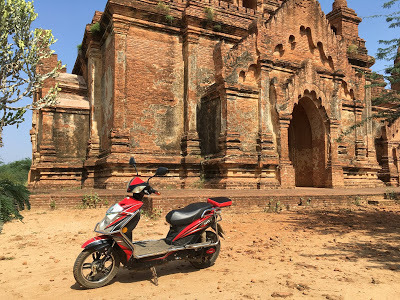
The Bagan Archeological Zone is spread out over a mostly flat plain that is over one hundred square kilometers in size. Outside of the ruined walls of Old Bagan, this UNESCO World Heritage Site is far too bit to explore on foot. Thus we found ourselves aboard what the locals call an E-Bike. It is a funny little means of transportation, a melding of E-Bike and scooter. They are for rent all over Nyaung U, costing 10,000 kyat per day. That works out to about $6.50, give or take.
The mission for today: Explore the far-flung temples and pagodas that rise like jagged teeth above the green flatlands. The area south and east of the walled city of Old Bagan is criss-crossed with earthen roads, farm lanes, and goat paths. The morning sky was hot and bright, devoid of the last of the rainy season clouds. We were about to put the little E-Scooter through its paces.
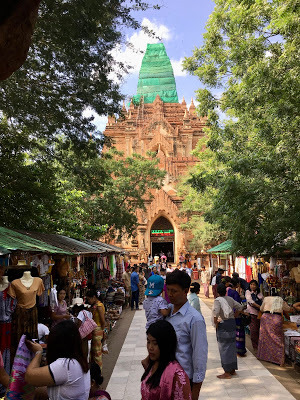
Piloting our electric steed through Farrang-Town, we emerged onto one of the main East-West roads. My goal was to get us out into the open country to the south of Old Bagan. I had a marginally vague idea of where we were going. It did not really matter, as the pagodas rise above the plain wherever one looks. It is simple thing, really. Choose one of the looming pagodas, then steer towards it. Veering off the pavement, we were soon bouncing down a rough earthen road, weaving around the many potholes filled by recent rains. I did the best I could to miss the bumps and spare My One a jostling, all the while getting the feel for my strange little electric moto.
Our first stop was a busy one, a lively temple crowded with local folks. There was an avenue of vendor stalls lining the entrance way, selling everything from snacks to religious icons. It was a festive scene. I find a certain small pleasure in being a traveler amongst local tourists. This is their culture, their pilgrimage, and their holiday. It is a privilege to be allowed into their world, and I enjoy it very much.
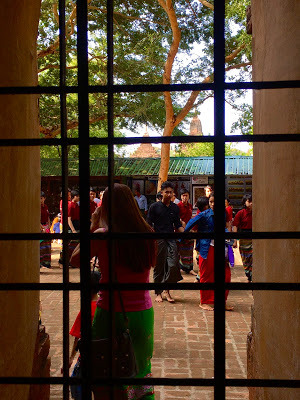
In a previous blog post, I mentioned the Gu-style temples. These temples are large squares or rectangles, usually topped with a pagoda spire. What is unique about the Gu-temples is that the interiors are accessible. Most of the stupas are solid structures built around an inner chamber. This chamber is usually the resting place of sacred relics, such as a few precious hairs of the Buddha. These reliquaries are not open to public viewing. The Gu-style temples, however, offer a unique view of the interior architecture employed by ancient builders.
The temples are blocks, and the inner passages conform to the outer shape. Thus we found ourselves in cool, shadowed passageways, with stone arches high above us in the darkness. Light flows in through open arches from the outside world. Other things flow in as well. Bats often make their homes in the nooks and crannies of the stone ceilings. One can hear their tiny squeaks while exploring the labyrinthine corridors.
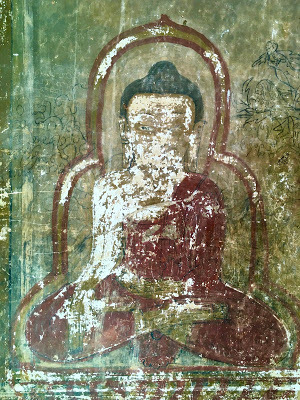
Let your eyes adjust to the dim light, walk slowly, and you will be rewarded with glimpses of what these walls looked like a thousand years ago. There are bits of fresco still adhering to the stone, painted images of the Buddha. Pictographic panels, worn with time and moisture, tell the fragmented tale of the Buddha's life and teachings.
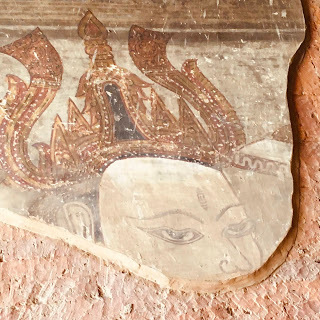
The temple walls were finished with a coating of limestone stucco. The stucco was then painted in myriad fresco designs. Most of the stucco coating is long gone, eroded away by the ravages of time, weather, earthquakes, and the touch of human hands. Yet fragments remain, transporting the viewer back through the centuries.
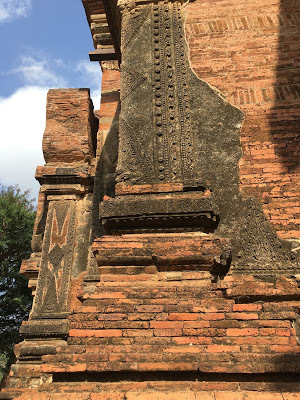
The Gu-style temples, like the chedi and pagodas, were built from stone blocks, often overlaid with brick. The brick was used to to build up the shape of the temple walls, and to fill the spaces between the sections of carved stone façade. The brick was then clad with limestone or sandstone. Most of this cladding has fallen away. It is particularly vulnerable to the many earthquakes that rattle this region. The bits of cladding that remain are stained a dark grey-brown. They still bear the mark of the maker's hands. The intricate geometric patterns and designs must have been an amazing sight when these temples were gleaming white above the green fields.
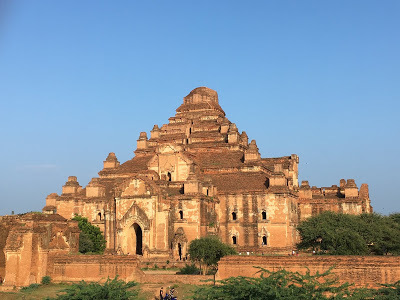
A Gu-style temple glowing in the sun in an awesome sight. The stone and brick climbs level upon level, and all of it topped with a crumbling pagoda spire. Multiply that vision by a hundred, two hundred, with temples and pagoda stretching as far as the eye can see. That is the Bagan plain on a brilliantly hot Myanmar morning.
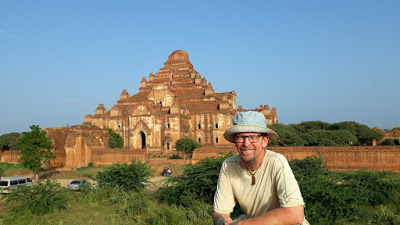
Truth be told, I was having as much fun riding the little moto as I was visiting the ruins. There was a wide swath of coutryside to explore. I gave up on caring where we were, piloting the scooter down smaller and rougher paths. Sliding down one very muddy section, I had to daub a foot to keep us upright. We managed to fishtail through, but not without the reward of one very mud-coated foot. That was worth a good laugh. By the time we got to the next temple, the mud had dried to a gummy cast. Fortunately, there was a pilgrim's foot washing station, which I took full advantage of.
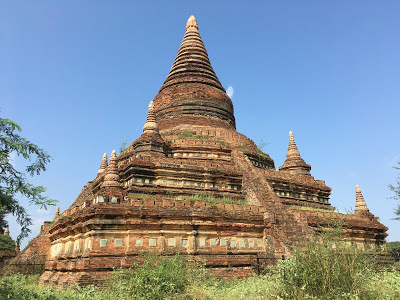
Bagan is all about seeing temples, yet there are only so many temples that one can see before fatigue sets in. To utter the refrain on touring Thailand: "Here a Wat, there a Wat, everywhere a Wat-Wat." It is no different in Europe. Medieval cathedrals are incredible structures, yet even the most dedicated traveler can only take in so many cathedrals in one journey. The massive buttresses and glorious stained-glass was meant to awe and humble the poor peons, and that purpose was well-served. I am awed and humbled as well, but when temple overload kicks in, well, it's good to have another source of fun.
Today, the fun was supplied by the little scooter. With our own transport, regardless of how silly, we were able to wander at will. When we got tired of busy temples, we sought out the smaller pagodas. There are many, many temples that sit alone and unvisited. They are scattered everywhere. Pull off a goat path, park the scooter, and you have your own private ruin. You could sit on the edge of the stone foundation and have a picnic. Or you could take a break, find a shady spot, and smoke a cheroot in peace.
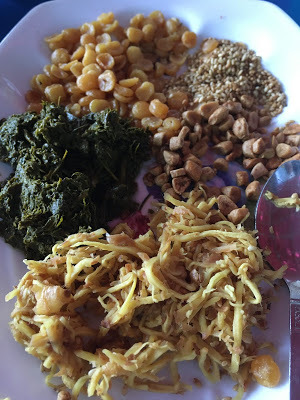
Lunchtime!!
The sun was beating down like a hammer on an anvil when I turned our scooter towards the village of New Bagan and lunch. New Bagan became a village around 1970, a product of forced eviction. This was the hey-day of the military junta, and the ruling generals wanted to clear the locals out of Old Bagan. The walled city was destined to become a heritage site (and tourist ghetto) so the local folks were in the way. Thus was New Bagan created.
Today, New Bagan is a prosperous little town which derives a great deal of its income from the tourist trade. It is particularly favored by the tour bus groups. There is a lively main street, chock full of cafés and tea-shops. We had no trouble finding one of each; first for a good lunch, then for tea and some leisure time.
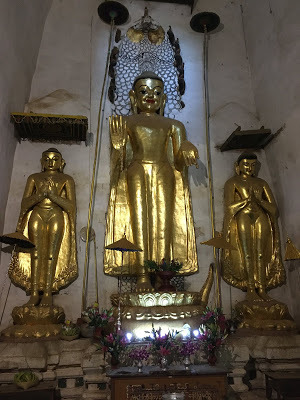
With the afternoon sun becoming fierce, the interior passageways of the Gu-temples were a welcome refuge. I had recovered my Temple-Fu and was honestly having a blast. We had given up all notions of destination, choosing our path by which dirt lane looked the most interesting. There was a good bit of getting lost, getting found, and giggling about it all. Putzing around on the silly little scooter was amazingly fun. We dawdled about from temple to pagoda, retreating into the shadows for a respite from the sun. Cooled off, we would saddle up once more and venture out into the baking heat.
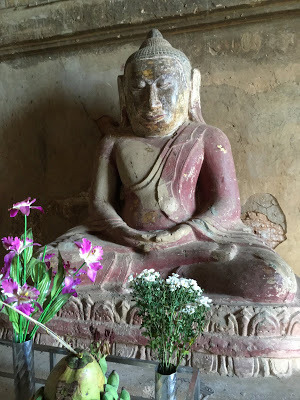
This was my favorite Buddha of the day, perhaps my favorite in Myanmar. There was something in the carved expression that held my eye. I loved the rose-coloured stain over the stone, and the unique form and style.
The late afternoon was upon us, and night comes quickly here. It was time to head for the barn. We navigated a circuitous route across the southern Bagan plain, with piles of stone on either side. There were famous temples, their dirt parking lots full of vehicles, and many smaller pagodas standing lonely and quiet. We passed them all by, enjoying the ride through the countryside, and the cooling of the day.
With a vague notion of direction, I aimed the scooter up a goat path leading out through the fields. Before taking the plunge, I checked with My One. She gave me the "Sure, what the hell" shrug, and off we went.
Packed earth gave way to rough gravel, then rocky patches, and even a stream crossing. We were doing it, motocrossing over the wild trails of Myanmar! This was, of course, a silly notion. No matter where I go in Southeast Asia, no matter how rough the path, or how bad-ass a moto jockey I think I am, I have to remember one simple fact. Some eighty-year-old Burmese granny has just ridden a 125 automatic scooter over this very stretch of path, and she was probably hauling 100 kilos of rice, a grand-kid or two, and a pig.
The path opened into a small lane, and the small lane into a road. Then we were out on the main road to town, traffic whizzing by us in the gloaming. A quick turn into Farrang-Town brought us back to the scooter rental joint. We bid our trusty steed adieu and walked back to our side of town.
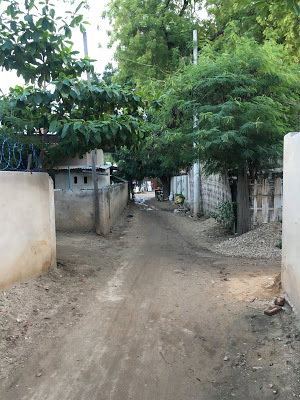
Our Little Street...
Our little alley was still there, as were the two old guys perched on their stools. We climbed to our guesthouse and a very welcome cool shower. The night fell quickly, and hunger came hard on night's heels.
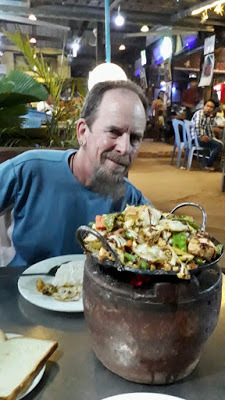
Nights in Bagan are sultry. The mention I made of the day cooling off is a relative term. It is cooler than the hammer and anvil of the midday sun, that is true, but the nights are still plenty warm. Yet that did not stop us from ordering our own personal charcoal brazier, delivered directly to our table. The thing was radiating heat like the ovens of hell. Brilliant planning, that.
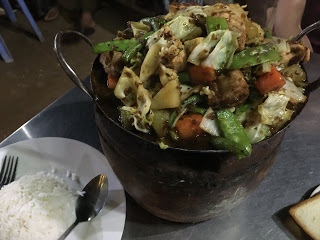
The glowing ceramic inferno notwithstanding, the hot-pot was a fantastic meal. Our BBQ joint was packed with folks, both local and Farrang. There was much eating, much drinking, and a good time seemed to be had by all.
Our time in Bagan had run to its end. Despite a few bouts of temple fatigue, I really enjoyed this part of our Myanmar adventure. There was a good mix of sights to see, tempered with great food and lots of interaction with local folks. Tomorrow we would set out on the road to Mandalay.

Thanks for your interest in my travel blog. I do hope you enjoy it. If you liked what you read here, please tell another reader. Word of mouth is the most precious gift an Indie Author can receive.
How about a free short story? My short story "The Broken Vow of Ramón Torres" has recently been featured at the great online review Inlandia Journal. You can check it out here:
"The Broken Vow of Ramón Torres" at Inlandia Journal
Or perhaps one of my other novels? All of the information is at my website:
Marco Etheridge Fiction
You can check out books, blog posts, book reviews, or even get a free book. Just look for the big button that says "FREE BOOK." It's kind of hard to miss. Happy reading!!
Published on December 14, 2019 03:52
December 12, 2019
Myanmar Lucky 13: Old Bagan Walkabout
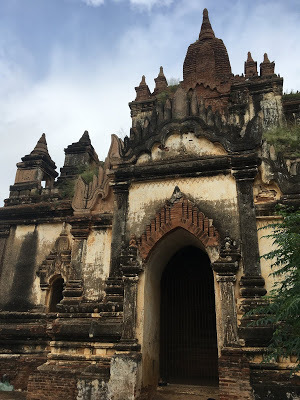
The Bagan Archaeological Zone is a flat plain along the Ayeyarwady River in West-Central Myanmar. Approximately 4,000 pagodas punctuate the 100 square kilometer area of Old Bagan. Everywhere one looks there are pagodas, stupas, and zedis. The structures range from towering and famous, to toppled and forgotten. My favorite sites are the Gu-Style hollow temples, of which more later.
Bagan, formerly Pagan, was the capital of the Pagan Kingdom from the 9th to the 13th centuries CE. These days, Old Bagan is a UNESCO World Heritage Site, a designation that attracts cultural tourists from all over the world. Bagan is blessed and cursed with the fame of being an Important Destination.
The folks that visit Old Bagan seem to fall into four groups. First, there are the Myanmar folks who are mostly here on various pilgrimages. Old Bagan may be an archeological site to tourists, but it is still very much a part of Myanmar Buddhism.
The second group are the well-heeled Culture-Tourists who can afford to stay at the resorts in Old Bagan. They are the same folks that rock-star into Luang Prabang, or Siam Reap: Fly in, see the good stuff, fly out. And yes, I know my snobby side is showing. What can I say? I Yam What I Yam.
The rest of us are the more-or-less independent travelers and those on bus tours. We hang out in the cheaper digs of Nyaung U or New Bagan.
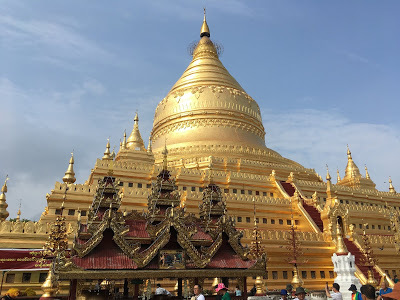
Shwezigon Pagoda
Many of the temples in Old Bagan contain statues of the Buddha, and these are still venerated by local folks coming to make merit. This area is very much an active religious site. One of the most important pagodas was only a short walk from our digs in Nyaung U. It was also the reason that all the guesthouses were booked. The pilgrims were in town.
Shwezigon Pagoda is not a ruined old stack of stones. This pagoda was completed circa 1100 CE, and has been in use more or less ever since. It was very much in use as we walked the long entrance passage that led to the pagoda. The lunar cycle plays an important role in Buddhist rituals, and this week's full-moon had brought pilgrims from far and wide.
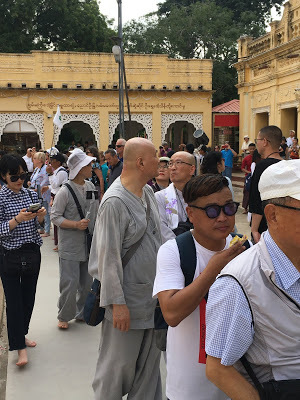
Bare feet met marble and stone as thousands of good pilgrims walked around the main stupa. All sorts of folks were making merit. There were a great many local Myanmar folks, but there were also pilgrims from other lands. I spotted grey-robed Buddhist monks, whom I believe were from Korea. Most of the camera wielding tourists were Asian folks, with the merest smattering of Westerners.
The mood was festive at Shwezigon Pagoda. Folks were having a good time. Laughing kids ran around chasing each other, and smiling folks posing for photos. There was even a cadre of young men and women running a promotion for a brand of energy drink. Jacked-up on their own product, they were handing out cans of energy drink as fast as they could get them unpacked. It struck me as one of the great anomalies that are so common in SE Asia: Energy drinks for pilgrims, garish LED halos over centuries-old Buddhas. So it goes.
Here is a link to a video of the scene at the pagoda, which is pretty fun:
Party Pilgrims at the Pagoda, Nyaung U, Myanma
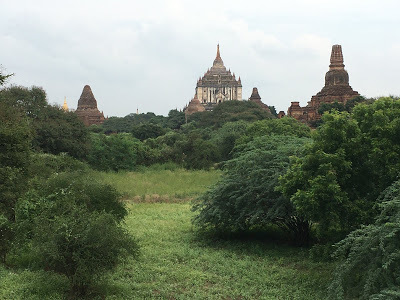
The Bagan Plain, where one is never out of sight of a pagoda. Three ruined chedi and a Gu-Style temple hover above the sultry green.
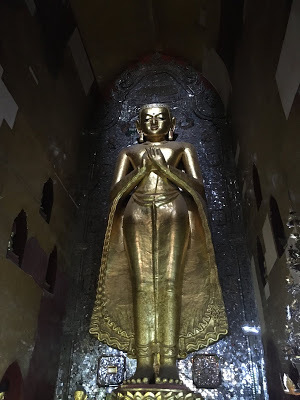
Many, many Buddhas
It is a long walk from Nyaung U to Old Bagan, so we opted for a Tuk-tuk. It's a funny thing about Tuk-tuks. These three-wheeled transports seem to be a sort of cultural marker for a region. The Bangkok guys favor decals featuring Al Pacino as Scarface. The Vientiane Tuk-tuk drivers, the most piratical of all, lean towards Sylvester Stallone and Cobra. The Myanmar Tuk-tuks, by contrast, are clean and neat, devoid of macho stickers, and the drivers are friendly and reasonably fair.
Yes, great, and what the hell is a Tuk-tuk?
This is a Tuk-tuk. It's powered by a small motorcycle engine that goes Tuk-tuk-tuk-tuk-tuk....
\/
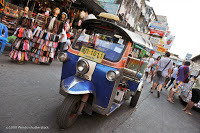
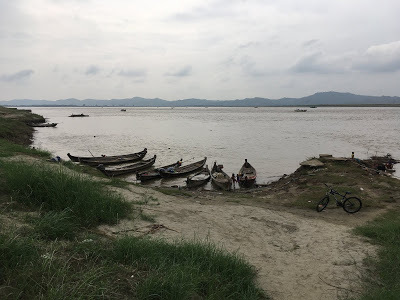
The Mighty Ayeyarwady River
Old Bagan is a maze of temples, pagodas, and Buddha images scattered across a few square kilometers, all enclosed within the ruins of the old city walls. Outside the tumbled walls, the Bagan Archeological Zone stretches out into the distance. Today, our walkabout was centered on the area within the walls. The walkabout became something of a mantra: Temple -- Shoes Off -- Buddha Statue -- Dirty Feet -- Shoes On -- Walk Down Jungle Path -- Temple.
Which is not to say that this isn't interesting and worth doing, but writing about it does present some problems. After the lively scene at Shwezigon Pagoda, Old Bagan left me a little under-awed. So, shifting gears, we threaded our way between two exclusive resorts, and descended a red earth path to the mighty Ayeyarwady River.
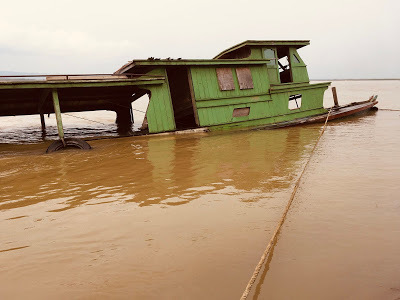
This is the Big River in a land of rivers. The Ayeyarwady (Irrawaddy by its colonial name) begins in the Himalayas and ends in the Andaman Sea. It is a big, brown, Mississippi of a river. Centuries ago this was the main transport link to the city of Mandalay. The river remains a important transportation route for goods and people.
I was happy to take a break from temples and tourists. We climbed around on the silty banks of the river, exploring this and that. Long, narrow boats were tied up along the bank, of similar style to the boats that work the Mighty Mekong. There were a few posh pleasure craft as well, the riverboat cruisers that bring the fancy folks to the fancy resorts just up the hill.
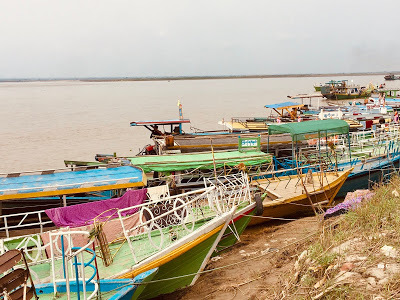
It was the weekend, a full moon, and a big day for locals to visit the temples. The ferry jetty was a busy place, with long-tail boats coming and going. The jetty itself is in reality just the river bank. Set back from the bank, steep stairways climb the hill to the flats above. The whole place was crammed with vendors, food stalls, and local families. An earthen road ran in from Bagan to the top of the stairs, then circled back on itself and ran back out. The road was a slow-moving pulse of tiny delivery vans, tractors hauling trailers, taxis, Tuk-tuks, and horse carts. Busy, busy, busy, as the Bokononists would say.
We slipped out of the mayhem and into a smaller lane of shops and curry huts. A Myanmar Grandma motioned us into her joint, got us seated, and told us we were having curry. Curry: it's what's for lunch. Once all the many dishes were on the table, Grandma and her granddaughter joined us at the table. The curry was good, although it was best not to examine the kitchen area with too sharp an eye.
The array of side-dishes included the odd bean-paste dishes that central Myanmar is known for. There are several strange, jiggly varieties, and they are lot more appetizing than they appear. Folks from other parts of Myanmar refer to the natives of this region as the Bean-Eaters.
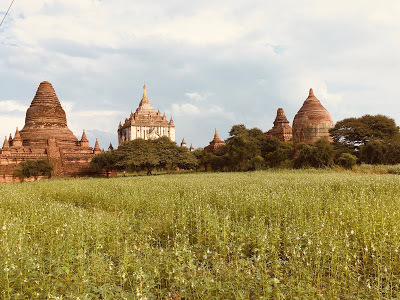
The stroll along the river and the craziness of the holiday crowd had me ready for more walkabout. We ambled away from the river and back into Old Bagan. A few more temples lay between us and the main road, where we could find a Tuk-tuk. One way or another, more pagodas were being added to our itinerary.
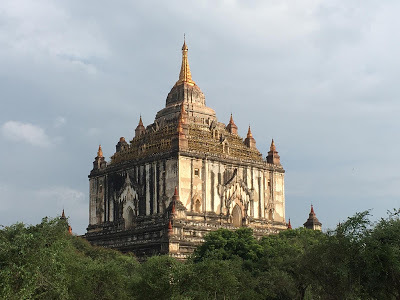
So here, then, is the obligatory big temple photo and description. I present this as evidence that we fulfilled our Bagan tourist obligations, at least for today.
This is the Thatbyinnyu temple, built circa mid-12th century by King Alaungsithu. It is an historic and massive temple, with Buddha statutes and whatnot. But more importantly, if one combines the name of the temple with the name of the king, one gets a devilishly difficult drinking game:
"Repeat after me: That-Binn-You -- Ah-Long-sith-U! Hahahahaha, you screwed it up, take a shot."
Yeah, and it's all downhill from there.
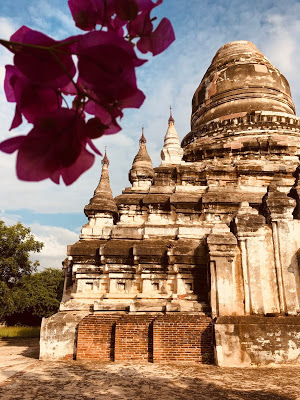
Truth be told, my favorite temples were the small, satellite pagodas, of which there were many. These are the shorter, less imposing, less famous temples. They are largely ignored, so they make for lovely wandering. There are no tourists, pilgrim or otherwise, no vendors, and no queues of buses.
When enough was enough, we hopped a friendly Tuk-tuk back to Nyaung U. I am forced to admit that I am getting soft. Squared off with a Bangkok, or worse, Pnom Penh Tuk-tuk driver, I will bargain like a old auntie in a street market. The Myanmar drivers have messed with me. First, they are smiley, and secondly, they start the pricing too low. I would certainly not drive them as far as they are driving me for the money offered. So I bargain enough to save face and off we go.
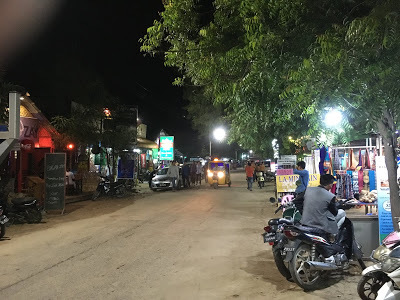
Restaurant Road...
Back in busy little Nyaung U, we picked up the threads of a mystery that had us puzzled: Where were the Farrang? Our guesthouse was on the river-side of the main road, an area mostly devoted to local folks. We certainly saw Farrang amongst the temples of Old Bagan, but where did they hide out when they were back in town?
The mystery was solved, indirectly, by My One informing me that tonight's dinner would most definitely not be curry. She looked up a few places online, and off we went. That is how we discovered Restaurant Road and Farrang-Town.
On the far side of Nyaung U's main drag, there is a flat bottom land divided by rutted lanes. It looks very much like a frontier town. There are guesthouses scattered along the lanes, as well as all the sundry businesses that cater to travelers. Cutting through the center of Farrang-Town is a busy, dusty road. Whatever the real name of the pot-holed street, even the locals call it Restaurant Road. Scooters and Tuk-tuks zip up and down, raising clouds of dust. Open-air restaurants and bars line both sides of it. Indian food, Italian food, burgers, pizza; it is all here. We had a lovely dinner at a cute café leaning hard towards the hipster-organic end of the spectrum. Sure, it was twice the price of a local meal, but it was a nice change, and the food was good.
When we scuttled back across the main road, it was as if a lock snicked closed behind us. Farrang-Town was on one side, our digs were on another. We dodged the traffic, threading our way to the mouth of a narrow, muddy alley. The same two old guys are always sitting there, so our turn is easy to spot. We give them a smiley Ming-gah-la-Bah and head up the alley. It is really dark, so one has to pay attention to the big puddles. It also pays to keep an eye out for scooters with no headlights coasting down the hill. Keep straight on past the huge pig, uphill to the big tree, and turn left onto the little lane. Voilà, you are home!

Thanks for your interest in my travel blog. I do hope you enjoy it. If you liked what you read here, please tell another reader. Word of mouth is the most precious gift an Indie Author can receive.
How about a free short story? My first non-fiction piece,"The Healing Sting," has recently been featured at the great online journal Route 7. Look for 'Non-Fiction' and click on my name. You can check it out here:
"The Healing Sting" at Route 7
Or perhaps one of my other novels? All of the information is at my website:
Marco Etheridge Fiction
You can check out books, blog posts, book reviews, or even get a free book. Just look for the big button that says "FREE BOOK." It's kind of hard to miss. Happy reading!!
Published on December 12, 2019 03:07
December 10, 2019
Myanmar Chapt. 12 : Overcoming Adversity in Bagan
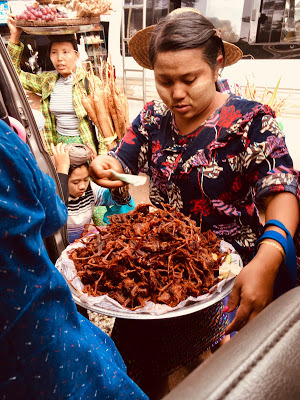
Bird Bits, Bird Bits, Tasty Little Bird Bits...
The Travel Gods do not always smile upon us, nor does the sun always shine, nor do the best-laid plans come to fruition. So it goes, tra-la-la. Every journey is going to have that day when things just fall apart. Today was that day. But first, we had to get from Meiktila to Bagan.
The vomit van picked us up at the hotel, a luxury afforded by being able to afford it. Sure, we spent about two dollars more than the locals, but we saved schlepping ourselves and backpacks to the mini-van stop. My One was still getting over a head cold, so I chalked it up to money well spent.
The vomit van was packed, no more, no less, and we the only Farrang aboard. We rolled across the countryside, watching the Myanmar countryside slide by the dirty windows. I let myself be lulled into the thought that there is nothing new to see, much to amusement of the Travel Gods. A funny bunch, those Travel Gods; always willing to liven things up.
"Ah, Bucko, is it new you want? Very well, as you wish, so shall it be..."
When the little van made the obligatory pit stop, the vendors came crowding round. One of the vendors was holding out an enormous platter of fried meaty bits (photo above). When I leaned over for a closer look, I realized that the snacks on offer were bird's legs. Now, I don't mean chicken legs, Friends and Neighbors, or even little quail legs. These fried bits looked to be the size and shape of a sparrow drumstick. Which, as it turns out, they were. I cannot swear to you that the scrawny little appendages were sparrow, exactly, but tiny birds they were.
I know you are asking yourselves the question, so I will cut to the chase. There is very little in the realm of street food that I have not tried, including wok-roasted spiders in Cambodia. I have to report, however, that these pathetic bird bits joined Balut, the Cambodian duck embryos, as a taste treat I had to take a pass on.
Oh, and if you doubt the spider-munching story, here is the video:
Tasty Cambodian Spider Treats
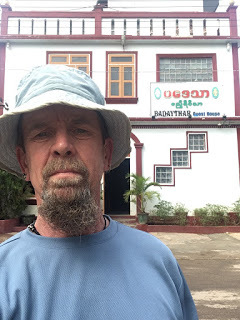
The Guesthouse that Wasn't
But we are rolling into Bagan, so it is time for things going wrong. To be more accurate, we are rolling into Nyaung U. There are three towns that make up the Bagan region, a wide flat landscape punctuated by thousands of pagodas, large and small. Nyaung U is a smallish town northeast of the old temple city of Bagan. This bustling burg is the headquarters for most independent travelers (read backpackers). Old Bagan became a tourist ghetto back around 1970, when the ruling junta booted all the locals out of the old city. A new village was established creatively called New Bagan. Old Bagan is dotted with high-brow and expensive resort-type hotels, where the well-heeled can stagger out of their digs and directly into the temple sites. New Bagan is, well, new Bagan, and the temporary home for most of the tour-bus type folks. Now you know enough to go on.
Still rolling into Nyaung U, and thanks to our friendly driver, we rolled right up to the doors of what was supposed to be our guesthouse. There were a a van-load of local folks checking into the place. The scruffy guy at the desk told us that we were at the wrong location, the other guesthouse was five minutes up the street.
Sketchy and doubtful, very doubtful, but it has happened before. We loaded back into the van and headed for the "Number Two" guesthouse. You guessed it, no guesthouse, at least not one with the correct name. We let the vomit-van go, as it was pointless to hold up all the other passengers. I marched back to the place, got the same answer, with more detailed evasions. One more loop on foot proved that the "Number Two" was a chimera. I finally cornered the owner, who admitted that he only rented to locals. This translated loosely into "I only rent to locals right now because there is a huge pilgrimage going on, and the whole town is booked solid."
So, the situation is this: Our reservation be damned, the locals are in, we are out, and the town is booked solid. Step one: Find a café with WiFi. Step two: Get my still-sick Sweetie a nice, cool drink. Step three: Try to get a last minute deal online. And... the town really is slammed, unless a body wants to fork over $100+ per night. This is where it gets fun. I set out on foot, leaving My Heart to guard the backpacks. It's hot, sultry, and I'm sweating bullets. I walk a long ways, about a four kilometer loop, and I have bupkis to show for it. The Travel Gods must have gotten their jollies, because at the last place, they finally relent. I find a modest little guesthouse devoted to Myanmar folks, a friendly, sympathetic host, and one last room.
There was no guarantee of a room the next night, but they would see what they could do. And of course it all worked out in the end. The next night they moved us to a more expensive room, which was still dirt cheap. There was a rooftop terrace for cigar-smoking, and the breakfast was great. we met some cool local folks, got to see the pilgrimage scene, and we managed to persevere without freaking out; close, but no freak-out.
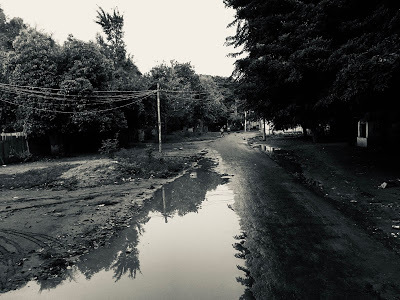
Settled and showered, with evening upon us, it was time for walkabout and dinner. Nyaung U abuts the mighty Ayeyarwady river. A long, tree-covered hill separates the center of the town from the muddy river. A late-season monsoon had hit the town just before we arrived, so everything was wet and steaming. The gloaming of the day brought out everything that is beautiful about the town. It was practically glowing.
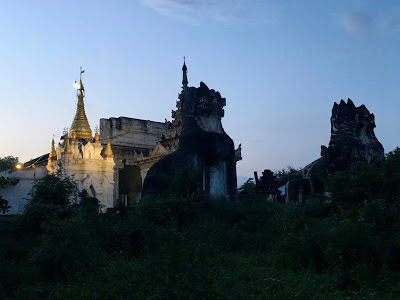
The gloaming of the day, when shadows grow long, and the oven-hot day cools to merely sultry. We met a Korean traveler in Yangon. He told us to avoid Bagan because it was the hottest place in Myanmar. His assertion is actually backed up by the annual weather patterns.
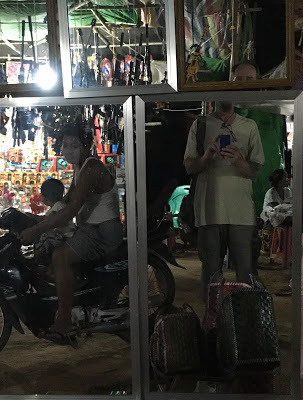
We found a night market that was clustered around the ruins of a pagoda complex. It was a maze of covered sandy walkways past brightly lit vendor stalls. Where there are vendors, there is food, because eating and shopping are a tag-team event in SE Asia.
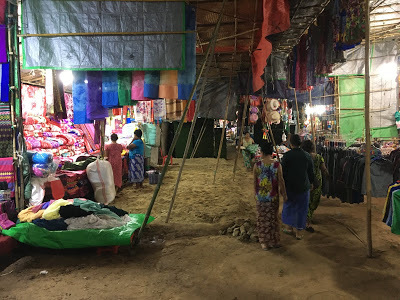
The maze of the night market led us to dinner and dinner led us to...
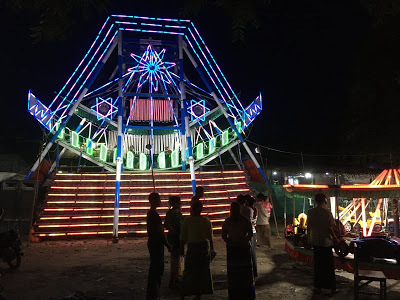
The crazy little amusement park that followed. Amusement park would be a stretch, even here. The attractions consisted of a hand-powered carousel, a giant bouncy castle, and a huge swing ride. If anyone was underwhelmed, they failed to show it. Kids were throwing themselves at the bouncy castle with wild abandon. Littler kids were riding the carousel, all the while squealing as if it were the best ride in the world. Teenagers climbed on and off the giant swing, while the operators used their body weight to assist the tiny power plant.
It did not matter that the carousel hand-spun by a guy smoking a cheroot. The kids didn't care that the bouncy castle was leaning hard to one side and barely staying inflated. And the folks on the big swing were throwing themselves at it for all they were worth, as if trying to send the rickety thing into orbit. Everyone was having a gas with what there was. It was magical.
Here is a link to my YouTube video of the hand-powered carousel.
Hand Powered Carousel -- Bagan
Here is a link to my YouTube video of the squealing kids on the carousel. If this one doesn't warm your heart, well: Jack, you dead.
Pure Joy Carousel -- Bagan
And, last but not least, the teenagers rocking the Big Swing:
Lo-Tech Amusement -- Bagan
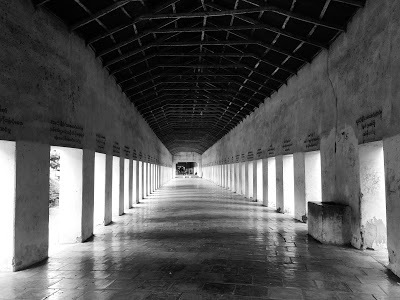
The Travel Gods had their way with us today, and yet everything came good in the end. Better than good, because our world got a little bigger. That's a blessing, and I will take all the blessing I can get.

Thanks for your interest in my travel blog. I do hope you enjoy it. If you liked what you read here, please tell another reader. Word of mouth is the most precious gift an Indie Author can receive.
How about a free short story? My short story "The Busker" has recently been featured at the great online journal Literally Stories. You can check it out here:
"The Busker" at Literally Stories
Or perhaps one of my other novels? All of the information is at my website:
Marco Etheridge Fiction
You can check out books, blog posts, book reviews, or even get a free book. Just look for the big button that says "FREE BOOK." It's kind of hard to miss. Happy reading!!
Published on December 10, 2019 11:22
Myanmar Chapt. 11: The Small Travel -- Meiktila
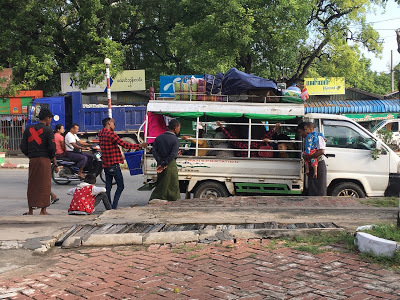
It would be a day of small travel and unexpected destinations. My One was under the weather with a head cold, and not up for any marathon train or bus rides. We opted for a short jump to Meiktila, the closest real town-town from our base in Thazi. Ah, the luxury of not being in a hurry.
In Myanmar, as in much of SE Asia, the best short-distance mode of travel is the pick-up 'bus.' These open sided pick-ups or utility vehicles are called Songthaew in Thailand. They have hard wooden benches down either side of the bed, and a steel canopy above for luggage, extra passengers, or both. It is not a comfy form of transport, but it's cheap. The other thing to know is that the Songthaew are often the only form of transportation, especially away from larger cities and towns. I never did figure out the Burmese name for these contraptions. Folks just call them buses.
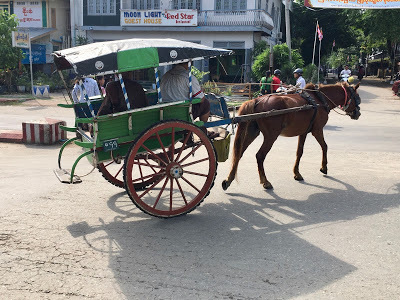
f you are in a seriously slow mood, there are always the horse carts. They may look like a romantic way to experience another era, but the horse carts are not here for tourists; not in Thazi anyway. The carts are pulled by small, scrawny horses. They are the same small breed of horse that pulls the carriages in Nakhon Lampang, Thailand. Local folks use them for short rides, and for hauling goods to the busy market. It's hotter-than-hot on the main street and the horses work hard. The drivers are not shy about applying a sharp flick of their goad to get the horses moving. My best advice to sensitive folks would be that the horse carts are prettier at a distance than they are up close.
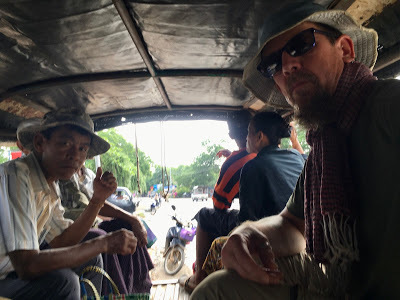
It was a travel morning, so we lashed up the backpacks, hit the local tea-shop for brekkie, then wandered over to the Songthaew stop. Our morning journey was about twenty-five kilometers and the fare about seventy-five cents per person. There is no real schedule for the pickups. They leave when they are full. It is important to note that full is a relative term. Full, in First-World terms, means that every place on the ass-busting wooden bench is full. This definition of 'Full' does really apply in this part of the world.
A pickup bus is full when the benches are smashed full, cheek pressed to cheek, there are men hanging off the back of the truck, and eight small boys are perched atop the luggage on the overhead canopy. Even this state of fullness does not really mean completely full. The Songthaew will still stop alongside the road if someone raises their hand, palm facing down. Then more lumpy rice sacks full of goods will be tossed up, and somehow another body will squeeze in, defying the very laws of physics. What is more amazing to me is how people deal with it. Even when they get a bit grumpy about the conditions, folks usually laugh, smile, or roll their eyes.
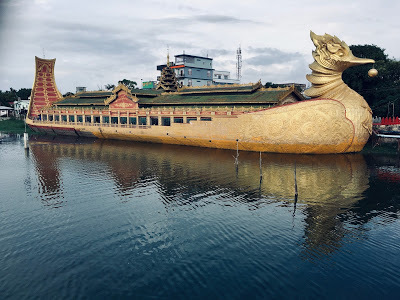
Thus we came to Meiktila. There were no other Farrang crammed into the little pickup, and no Farrang on the streets of Meiktila. This is a busy town, a transportation hub, a provincial market town, and a university town. There are three universities scattered around the lakes that surround Meiktila. What Meiktila does not have is important tourist sights. Sure, there is the huge floating monastery shaped like a goose, but that's about it. Tourists do not usually stop here.
Meiktila reminds me of some of the favorite provincial capitals in Thailand, the type of small city that the Lonely Planet might give a pass. Therein lies at least the potential for hidden beauty and quiet travel. Like the aforementioned Nakhon Lampang, or Chiang Rai, Meiktila is a vibrant little city with a real life of its own. The town is not dependent on tourist trade, which makes it a good spot to experience how real life happens in Myanmar. It is a place for walkabout, without destination or expectation. This is a town where you will be noticed. Farrang on the street are a novelty. Open bus-loads of university kids will smile and wave at you. If you wave back, they will go crazy, laughing and giggling and shouting.
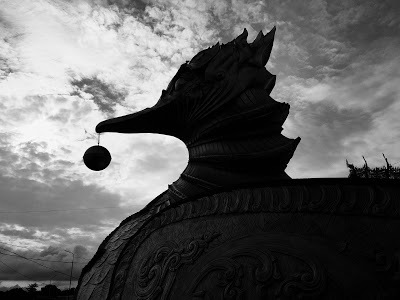
Phaung Daw U Paya is the big photo op in Meiktila. The huge floating barge is shaped like karaweik, a mythical bird. The original is a famous floating palace in Yangon. This is an iconic image in Myanmar. It is emblazoned on shop signs in every town in the land, on beer labels, and on Myanmar tea.
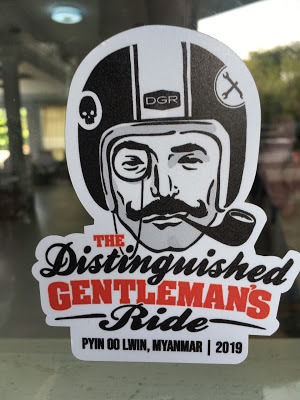
For my moto friends scattered across the globe: It is good to know you are not alone.
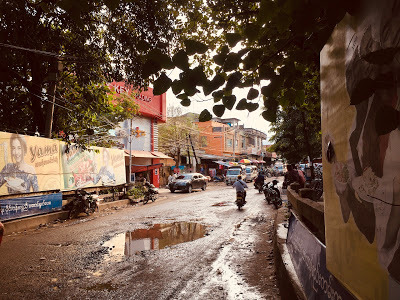
There is a specific style of colonial-era architecture in Meiktila that I have never seen before. Scattered amongst the newer shophouses are late colonial façades built in an almost art nouveau style. They are modest structures, only one or two storeys tall, stained by the black mold that are slowly eating them away. They stand as a decaying monument to Meiktila's past.
The history of this town has not always been a happy one. This was the site of fierce fighting during World War Two. The Burmese theater is often call the Forgotten War, overshadowed by the more famous battles in North Africa, Europe, and the Pacific. But for soldiers of many different lands, this was a very real, and very bloody battlefield. Meiktila was a strategic transport town, a key to the 1944 British-led offensive to recapture Burma. The town was heavily defended by Japanese forces, and the fighting was brutal and bloody.
Modern Meiktila has another sad legacy. In 2013, tension between local Buddhist and Muslims reached a critical mass, fueled in large part by animosity against the Rohingya people. A small spark ignited rioting and mob violence. When it was over, more than forty people were dead and many more injured. At least 9,000 residents were displaced by the violence. As I mentioned in an earlier blog post, the issue of displaced Rohingya is an ongoing problem for the Myanmar government.
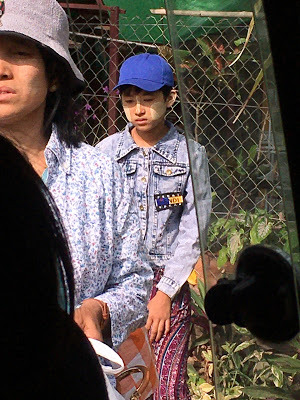
One of the distinct customs of folks in Myanmar is the wearing of thankkha, an earthen paste that is applied to the cheeks, nose, and forehead. Like the purple-stained teeth of the betel chewers, it becomes a familiar sight.
The paste is worn over the face for cooling and for protection from the sun. The custom can vary from a child smeared with the stuff, to artful designs on the faces of stylish women. It is primarily a custom for women and children, both boys and girls. It is rarer for men to wear the thankkha. Many families make the paste at home, or buy it from a local producer in their village or town. It is very much a product of the region.
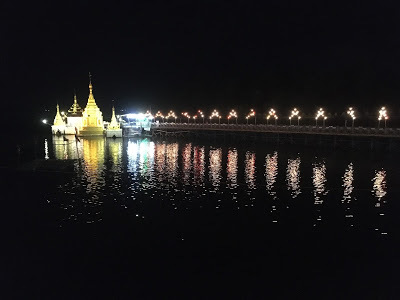
One might ask the question: So what did you do there? The answer would be: Nothing much in the sense of great adventure. Viewed through the close-up lens, we did a great deal. We wandered the sprawling market, ducked into tea-shops when it rained. The local folks hang out down by the lake shore, and we joined them. People greeted us and we greeted them. Meiktila offered us a good view into what normal everyday life is like in Myanmar.
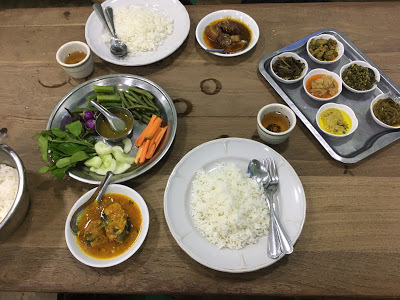
And, of course, we ate. This town offered up the best Myanmar curry so far. The particular curry pictured above is a fish curry, complete with all of the ubiquitous side dishes.
Meiktila proved to be our pit-stop, a jog away from the more traveled ways. To be sure, the tourist trail in Myanmar is quiet this time of year, and always quiet compared to the well-worn routes in Thailand.
From here we would travel to Bagan, Temple Central, perhaps the most famous destination in Myanmar. Night and day, small travel and large, all of it makes up the journey. I was glad for a chance at the small travel.

Thanks for your interest in my travel blog. I do hope you enjoy it. If you liked what you read here, please tell another reader. Word of mouth is the most precious gift an Indie Author can receive.
How about a free short story? My short story "The Crying Man" has recently been featured at the great online journal Literally Stories. You can check it out here:
"The Crying Man" at Literally Stories
Or perhaps one of my other novels? All of the information is at my website:
Marco Etheridge Fiction
You can check out books, blog posts, book reviews, or even get a free book. Just look for the big button that says "FREE BOOK." It's kind of hard to miss. Happy reading!!
Published on December 10, 2019 00:51
December 5, 2019
My First Non-Fiction Piece Published!

I am thrilled to interrupt the travel blog for a special announcement! My first published non-fiction piece, "The Healing Sting," just went live on the great online journal Route 7. I am honored and grateful to the editors for choosing my work.
"The Healing Sting" is a memoir of childhood, and memories carried into later life. I hope you will take the time to give it a read, and to support the folks at Route 7.
The general link for the current issue of Route 7 is here:
Route 7, Issue 7
The specific link for "The Healing Sting" is here:
"The Healing Sting" at Route 7
Thank you for supporting Indie Authors, and thank you for being readers. Readers Rock!!
Very Best Regards,
Marco
Published on December 05, 2019 11:49
Myanmar Chapt 10: The Real Slow Train
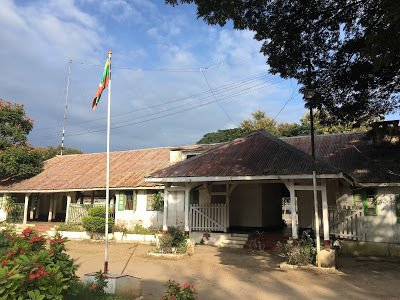
Shwenyaung, a Station from Another Time...
My Heart and I were up early, bustling around the bungalow, performing the last check for stray belongings. Out host had breakfast boxes ready for us, and a taxi was standing by. The plan was coming off perfectly. We needed to leave at 7 AM to ensure that we would be on the 8 AM slow train to Thazi.
The departure time was written in stone. Our smiling host had confirmed the time. The smiling woman at the travel kiosk had confirmed the time. The information on the internet agreed with all of the smiling people: Eight AM, Bubba. Be there or come back tomorrow.
The taxi whisked us away from Nyaungshwe, through the dusty streets and out onto the raised causeway along the lake shore. It is thirteen kilometers from Nyaungshwe to the train station in Shwenyaung. We did not know it, but at that moment our taxi was moving at a greater velocity than any other transport we would ride this day.
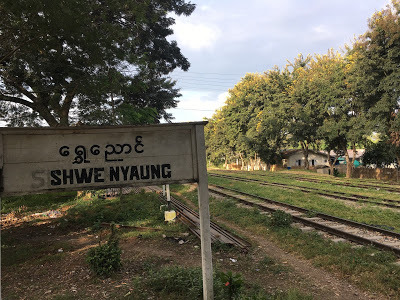
When we arrived at the colonial-era train station, everything was quiet. Too quiet. Before I could torture any more movie tropes, we found out why the station was so sleepy.
"No, train leave eleven o'clock today. No train eight o'clock."
Thus spake the most official looking of the clustered gents in the ticket office. There was no explanation, nor did I ask for one. What did it matter why? I was sure I could hear the soft snickering of the Travel Gods in the background. Welcome to a part of the world where schedules are theoretical.
It is 147 kilometers from Shwenyaung to Thazi via the twisty highway. The train takes a more circuitous route through the mountains, something more like 200 kilometers. That distance requires ten hours, twenty kilometers per hour, or about twelve miles per hour. When the three hour delay was added on, our arrival time in Thazi would be about nine PM. My Heart was not pleased, but there was nothing else to be done.
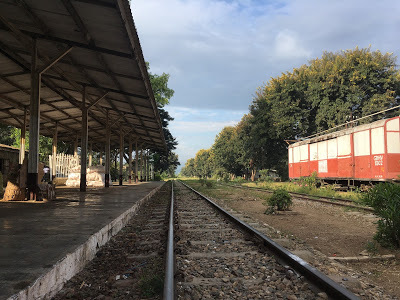
The first thing was to find a tea-shop. There is always at least one shop tea-shop near any station. Where else would the taxi drivers find a place to not work? This shop was a particularly good one. The owner was frying fresh Chinese donuts while his wife flipped and kneaded the dough. One of the sons plopped down our two cups, along with two piping hot strips of fried dough. Oh, hell yes! our total bill for two teas and two donuts: 800 Kyat (about fifty-five cents). We drank, we ate, we smoked, and time passed. There was a lot of time to spare.
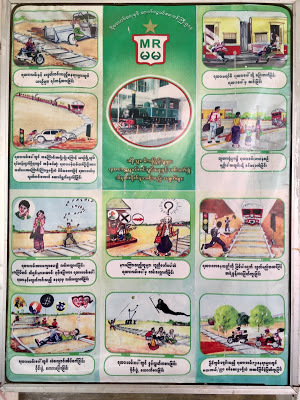
Trains are Sneaky, Dangerous Things...
Back on the rustic station platform, there was nothing to do but wander around. I poked around old train cars, smoked a cheroot, and learned about all the many ways a train can kill you if you aren't paying attention.
Here is where this blog veers into a photo essay, at least until the train arrives. How much can one write about waiting in an empty station? Oh, wait, I forgot to mention the schadenfreude of passing on the news of the delayed train to the newly arriving passengers-to-be There was some fun to be had in that.
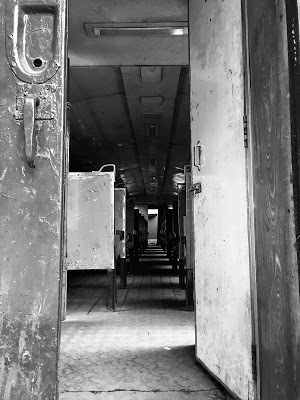
The Ruins of the Past...
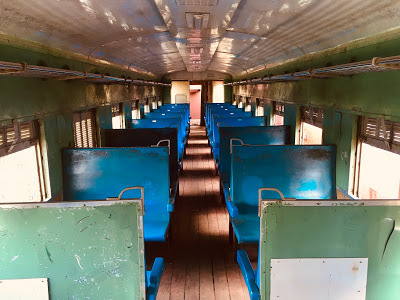
What I took for an abandoned train wagon was, in fact, a working car. Not long after I took this photo, a train hooked up to the thing and hauled it off.
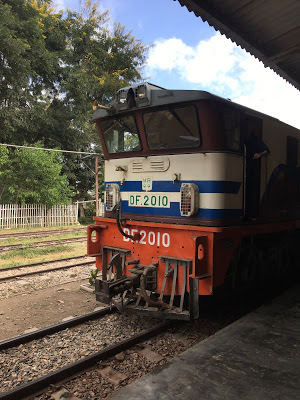
Our Train Cometh...
The sleepy morning air was broken by the long whistles of our approaching locomotive. Yes, our train had finally cometh. The thing was a rolling museum piece, it's true, but it was a bona fide locomotive, and the only one we were going to get.
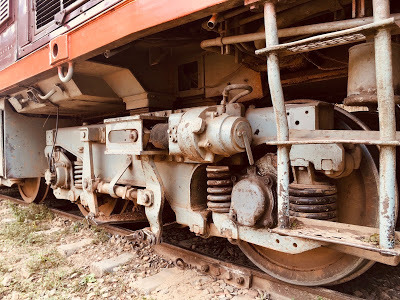
Vintage Running Gear...
It is down here amongst the running gear that one gets a clear picture of how old these trains really are. I am here to tell you, Friends and Neighbors, this ain't no Johnny-Come-Lately machinery. This stuff here is the Real McCoy.
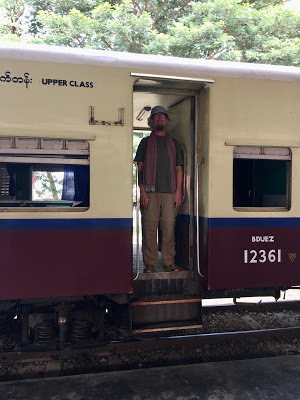
An Upper Class Wanderer...
After some shenanigans in the station, hand-loading piles of lumpy sacks and what-not, the whistle sounded again and our train lurched reluctantly to life. The little-train-that-might rolled across the last bit of flatland before the mountains. At the first slight incline, I was sure that I could hear the locomotive groaning in pain. Thus began our climb up into the foothills, up to the heights of the tea plantations that this train was built to serve. It was a long climb, and slow.
Words do not accurately describe our stately pace. I shot a few videos through the open window, videos which capture the awe-inspiring lack of speed our little train could sustain.
Here is the first video link, the train crossing a trestle with the snaky highway in the background:
Climbing out of Shwenyaung on the Slow Train
And here is the slow climb up the escarpment, the train curving back on itself through jungle and field:
The Real Slow Train: Shwenyaung to Thazi, Myanmar
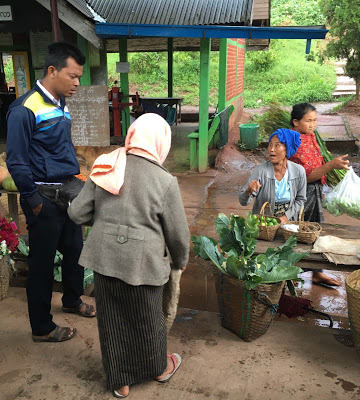
The train stops in the middle of nowhere. It stops because there is only one track, and another slow train is coming from the opposite direction. It stops in any and every hamlet along the way. This is the market train. Piles of goods are loaded into the wagons, and other piles of stuff are unloaded. Lumpy bags of cauliflower, onions, and other produce are stashed in the aisles or behind seats. The Upper Class wagon is just as suitable for vege storage as the Ordinary Class.
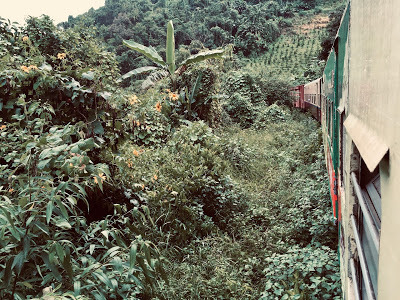
Jungle scrapes the side of the car with leafy hands. Branches bounce along the roof. There is a train-sized hole punched through the jungle. The jungle grows back faster than the train wagons can knock it down. At first, the sound of a branch scraping the roof is alarming. After a few hours, one does not hear it anymore.
The train becomes a movie, a very slow avant-garde film that will take all the time it needs to tell a quiet story. We passengers aren't watching the movie, but rather we are in it: extras trapped inside the set of a few dilapidated train wagons. We are carried the length of a very long saga in which we play only the most minor of roles. Like Rosencrantz and Guildenstern, we are adrift in the long pauses between speaking lines.
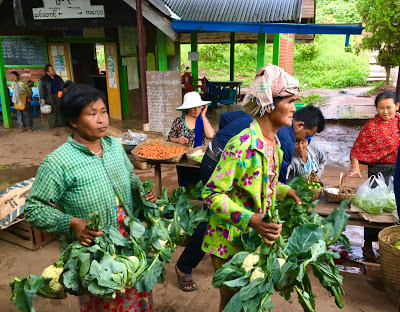
The folks that live in these hamlets are mostly Pa'O people. They are a Tibeto-Burman people who have inhabited this region for over a thousand years. The Shan State saw it's share of conflict with the former Myanmar Junta. Those armed conflicts drove many Pa'O people into the refugee camps around Mae Hong Song in Northwestern Thailand.
A gentle afternoon rain begins to fall. I see a few parties of Farrang trekkers slogging along steep pathways. They follow their Pa'O guides, pause on the long walk to wave at the train.
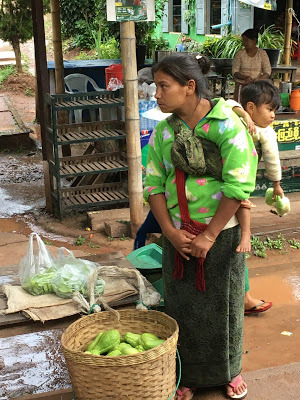
The arrival of the slow train is the big event of the day in these remote jungle hamlets. The train sits in each tiny station until all of the business is done, every last sack loaded, and the conductors have finished buying their snacks.
The evening is upon us, and we begin our descent from the mountains. The train has been snaking back and forth in sinuous curves, but eventually the slope becomes too steep. Our little train full of produce begins to zig-zag down the jungle mountainside. The trains stops on a siding, encased in a green tunnel of overgrown foliage. A switch is thrown, and we begin backing down the slope, descending the first zig. Then comes another siding, another switch, and we are moving forward again, down the zag. Lurching backwards and forwards, with a long pause at each siding, the train worms its way down to the valley below.
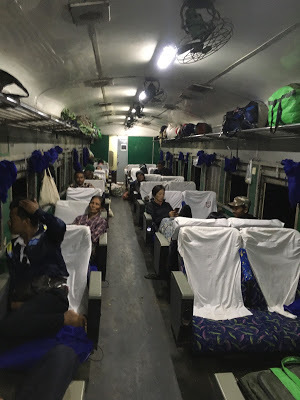
"Night time on the City of New Orleans..."
Night has fallen before we are on the lower slopes of the mountains. Insects pour into the train wagon, pulled in by the glow of lights and a death-wish. The dragonflies go into a feeding frenzy, bugs land on passengers, are brushed off, and the train keeps chugging into the darkness.
The conductors and baggage guys are playing cards, a blanket spread out in the aisle between the seats. The train finds the flatlands past the mountains and begins racing for home, speeding along at almost fifteen miles per hour, a velocity that is almost unbelievable.
Then we are there, pulling slowly into the station. We unkink ourselves from our seats, shoulder our packs, and slip past the huge bags of cauliflowers and who-knows-what. Back in Thazi, we know our way to the guesthouse. We are leaving the magic of the slow train behind. The memory of it will be more romantic than the last two hours actually were, but that is the nature of memory.

Thanks for your interest in my travel blog. I do hope you enjoy it. If you liked what you read here, please tell another reader. Word of mouth is the most precious gift an Indie Author can receive.
How about a free short story? My short story "Ghost Hats" has recently been featured at the great online journal Literally Stories. You can check it out here:
"Ghost Hats" at Literally Stories
Or perhaps one of my other novels? All of the information is at my website:
Marco Etheridge Fiction
You can check out books, blog posts, book reviews, or even get a free book. Just look for the big button that says "FREE BOOK." It's kind of hard to miss. Happy reading!!
Published on December 05, 2019 02:45
December 3, 2019
Myanmar Chapt. 9: Quiet Days and Harmless Hounds
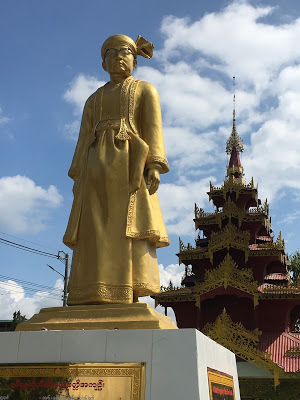
Sao Shwe Thaike and His Spectacles...
My Heart and I agreed to another quiet day before moving further across Myanmar. Herein lies one of the huge benefits of independent travel: The freedom to stay or go as whim takes us. There is no schedule, no bus waiting in the parking lot, and no perky guide hoisting a green umbrella for all the ducklings to follow. The down-side, for some, is being responsible for all of the planning, finding guesthouses, and making decisions. Given that someone had to decide something, we decided to remain in the small town of Nyaungshwe on the shores of Inle Lake. We like it here; reason enough.
Wandering on a slow walkabout is an excellent way to find things that were not being sought. For example, we found a statue wearing glasses. The statue was life-sized, and the spectacles appeared to be the glasses that Sao Shwe Thaike had worn in life.
It was a hot sun that beat down on the gold-panted statue of Sao Shwe Thaike, but I paused to read the English-language summary of his life. As a young man, he served in the British army in World War One. In 1927 he was named the Saopha, of "Lord of Heaven," of Yawnghwe, one of the Southern Shan States. Sao Shwe Thaike was the regional home-town hero. The home-town hero made good, and he became the president of the newly-independent Union of Burma in 1948. Sao Shwe Thaike warned of the young nations instability in the face of ethnic insurgencies and armed conflicts. He fell to the forces of the military junta that took over Burma in 1962. The home-town hero of Nyaungshwe died in prison that same year.
To begin to understand Myanmar, one has to learn about the many ethnicities that make up this land. The British left Burma in 1947, as they had left their colonies in India, but they did not take all the their troubles with them. Burma was called a union, but it was far more an amalgamation of diverse ethnic regions. The nation is made up of eight major ethnic groups, each with their own language or dialect. There have been many armed conflicts between these different groups and the Bamar, or Burmese-speaking majority. Those conflicts have continued into very recent times. When I was in Northwest Thailand in 2012, where the Shan and Karen (or Karin) were still fighting the forces of the military junta in Myanmar, operating from bases just inside Thailand.
The modern-day nation of Myanmar retains that ethnic diversity, and still struggles with it. One of this country's poorest ethnic groups are the Rohingya people, and conditions for them have not improved. Quite the opposite. The Rohingya are a Muslim people in the predominantly Buddhist Rahkine state. During WW2, the Rohingya fought with the British against the pro-Japanese Burmese forces. After WW2, Burma became an independent state and conflict with the Rohingya followed. The conflict, often violent, has gone on for half a century. Following renewed attacks in 2016, Myanmar's military cracked down on the Rohingya. That response earned the new Myanmar government a black-eye from U.N. High Commissioner for Human Rights.
This is the briefest of summaries, brought about by stumbling onto a spectacle-wearing statue in a quiet, sun-drenched square. If the reader is wishes to learn more about Myanmar, and Burmese history, there are are many sources for further reading.
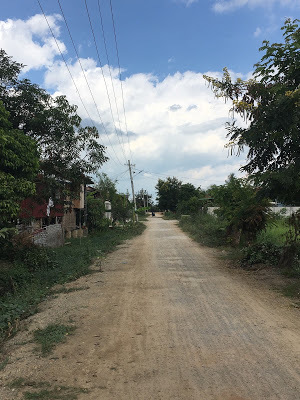
Quiet Lanes on a Quiet Day...
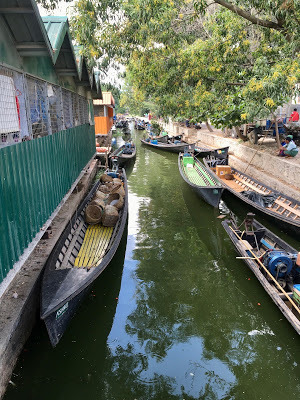
Not All Roads are of Earth...
My Heart and I wandered past the busy hub of the town, venturing out into the small lanes that ended at the marshy grasslands and rice paddies. There are streets of water as well, smalls canals that lead to the main canal, and hence to Inle Lake. Water is never far away in this valley, and as much moves by boat as by road.
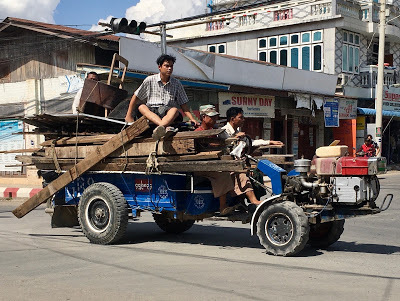
Hauling the Goods...
Circling the edge of the green fields, we passed by an extended arm of Inle Lake. Local folks were fishing from the dikes that contain the waters. We came back into town by the busy main street, where goods moved amongst the flow of scooters.
There are strange contraptions here on the streets and farm lanes. My favorite vehicle is what I call the modular truck. The thing comes from the factory as a bare-bones piece of rolling stock, an open frame coupled to a large truck bed. On the front of the truck is an empty steel platform where an engine is mounted. I have seen all manner of these utility vehicles, and all manner of engines propelling them. They resemble the skeleton of a lorry powered by a giant lawnmower engine. The engines can be unbolted from the trucks and used to power other equipment. The same engine may drive the long-handled tractors that the farmers use to haul carts, or they may be bolted to the insect-like earth tillers that crawl across the rice-paddies on paddle wheels.
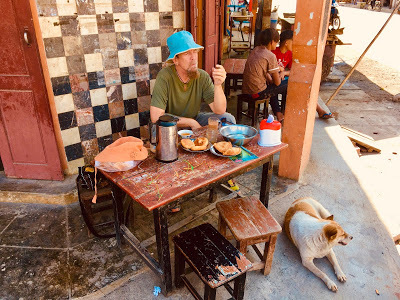
A Highly-trained Expert at Work...
Walkabout on a hot day should be followed by sit-about in a cool place. I know of no better in this town than the local tea-shop I have adopted as my own. It was time for tea, snacks, and an idle smoke. What better way to pass the heat of the day than a shaded cat-bird seat, watching bustle of a small-town main street?
You might notice the peaceful dog sharing my shady spot. This leads me to something I have been puzzling over: The mellow nature of Myanmar mutts.
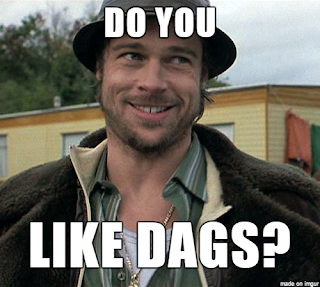
Myanmar is a remarkable land, but there is one aspect of the country that I have not remarked on: The Dogs. Whether street dogs or village dogs, free-roaming canines are a common sight in Southeast Asia. There is a commonality amongst the dogs of this region. Most of the mutts are a variation on the Indian pariah dog, or Desi Dog. The smaller version of dog is the Village Dog. Both of these varieties are a landrace of dog, meaning a domesticated, locally adapted version of a species of animal, in this case a pooch. The things one learns whilst researching a blog.
The Myanmar mutts, like the rest of their SE Asian cousins, are semi-wild, yet semi-socialized canines that live in contact with human settlements. Their development is one of evolution, rather than direct breeding by humans. Think of them as the reminders of ancient dogs who started nosing around human villages more than 15,000 years ago.
These dogs may look more or less the same, but I am here to report an odd observation. The Myanmar doggies, unlike their Lao, Thai, and Cambodian cousins, are mellow beasts. Why that is, I cannot tell you, but it seems to be true. Thai dogs will dog (sorry!) your heels, generally making pests of themselves. Laotian dogs are growlers and barkers, and can be a threat when they form a pack. Cambodian dogs are the worst, at least in my experience. They are sneaky cowards, creeping up behind a solo walker on a quiet pathway. One needs to reach for a throwing stone, and the cowards will scatter.
In Myanmar, however, we had not a single issue with street dogs. I noticed it on our first walkabout in Yangon. The dogs just lay about, are generally neutral, and sometimes even friendly. It took a little getting used to, but the mellow mutts were a fine change from their snappy Cambodian cousins.
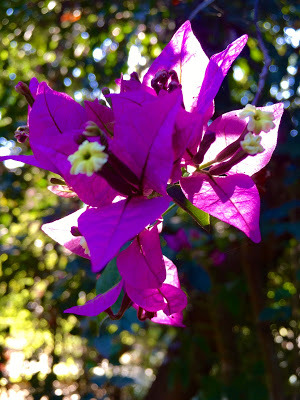
The day passed as quiet days will. There is a luxury in slow travel, allowing one to notice the small details, the little things that are not important attractions from the guidebooks. I believe that one of the most important lessons a traveler can learn is when to slow down. A land and culture are often revealed more through experiencing the small and mundane, rather than the grand and important.
I believe this to be true of any destination, including my own homeland. An eager tourist can pass through the United States having seen Mount Rushmore, the Grand Canyon, and Disneyland. They can see and experience those wonderful sights, and more besides, and yet still not get a glimpse of what my native land is all about.
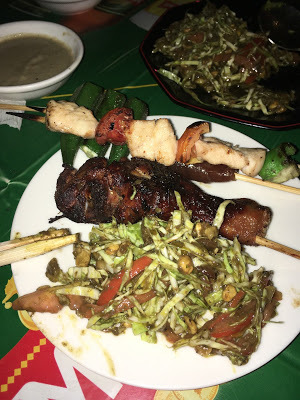
A quiet day passed, and thoughts turned to food. The luxury of time in one place afforded us the benefit of choosing a favorite dinner spot. So it was that we found ourselves back at our local BBQ joint, noshing on grilled skewers and plates of the local salad.
Allow me one more thought on food before I close. The guidebooks will tell you that folks in Myanmar will make a salad out of anything. I am here to tell you that not only is that true, but the end results are fantastic. During our time here, I was becoming very fond of the local tomato salad, very fond indeed. But that is just the start of it. There are many variations on the same theme, including avocado salad, bean salads of all types, and even tea leaf salad. They are delicious, cheap, and filling.
Our quiet day turned to quiet night, and our last night on the shores of Inle Lake. Tomorrow would bring more traveling, this time on the slow train back to Thazi. But that is the stuff of another blog post.

Thanks for your interest in my travel blog. I do hope you enjoy it. If you liked what you read here, how about a free short story? My short story "Orphaned Lies" has recently been featured at the great online journal Dime Show Review. You can check it out here:
"Orphaned Lies" at Dime Show Review
Or perhaps one of my other novels? All of the information is at my website:
Marco Etheridge Fiction
You can check out books, blog posts, book reviews, or even get a free book. Just look for the big button that says "FREE BOOK." It's kind of hard to miss. Happy reading!!
Published on December 03, 2019 02:47
December 2, 2019
Myanmar Chapt. 8: Inle Lake
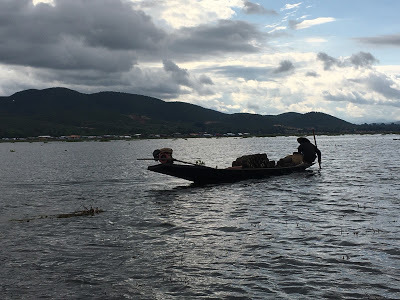
Morning on Inle Lake...
Inle Lake is a wide, shallow lake bordered by wetlands. The lake covers a flat valley and is not deeper than twenty feet, even in the rainy season. The lake drains into the Balu Chaung River, and hence to the Salween River. The Salween reaches from the Tibetan Plateau to the Andaman sea, a water journey of 1,750 miles.
More than the sum of its geographical facts, Inle lake is one of Myanmar's big destinations, a place that is likely to be on the itinerary of any traveler to this land. Good travelers can tour the lake by chartered boat, float over the valley in a hot-air balloon, or sleep atop the very waters in a hotel on stilts. There are iconic photo opportunities, floating markets folks demonstrating local crafts, and every exit leads through the gift store. You cannot blame the locals for this; they learned it from us.
Argh, we cry! tearing our hair at the flood of tourists despoiling the land. Yet as travelers, we are the very force that brings the flood. Let us say that I find an idyllic hideout, a wonderful hamlet in the karst mountains of Laos. Returning home, I write about it in my blog. Another traveler reads the blog, then visits the same hamlet. Soon, there is a small trickle of travelers passing through. The trickle gets noticed, and the place receives a mention in Lonely Planet. It is something like the traveler's version of Einstein's Relativity: The point of view of the observer (read traveler) has a direct effect on that which is observed (the destination). My brainy physicist nephew may take issue with the analogy, but I believe it to be true: We change a place by stepping foot there.
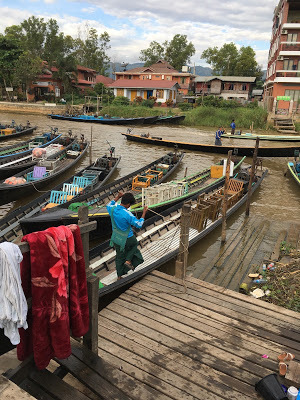
Boats Without Tourists...
Our boatman met us in front of the guesthouse at 7:30 sharp. A brisk twenty-minute walk brought us to the intersection of the main street and the main canal. As on the day before, there were far more empty boats than there were tourists to fill them. These are dragon-tail boats, long and narrow, with shallow drafts. The same basic design plies the waters of Thailand, Cambodia, Laos, and Vietnam. The screw, or propeller, is mounted on the end of a long shaft. There is usually a skid-cage around the prop to keep it from hitting the bottom of the lake or river. The three-meter shaft projects far out over the stern. At the business end of the shaft is an unmuffeled car or truck engine mounted on a pivot. The boatman swings the entire assembly on the pivot, thus steering the boat. The boats make a hell of a noise, and cast a churning spume not unlike a long dragon tail. Hence the name long-tail boats.
Here is a video of one of the long-tails in action:
Heading Out Onto Inle Lake -- Video
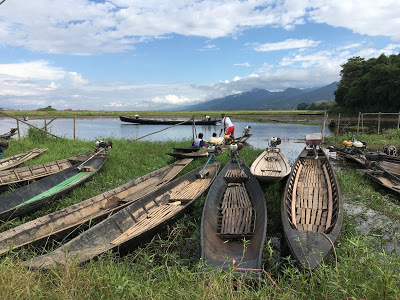
We are skimming across the mirror of the lake, and the morning light is amazing. This is all that I want, to glide across the water and look at things. But that is not the entire tour. We must see the daily market that rotates between small villages, see the floating towns, and tour the handicraft workshops. I am okay with all of that, but my heart's desire is only to watch the light on the water.
The lake glows silver, reflecting the mountains and clouds. The scene is washed in silver light. Then the sun breaks past the clouds, and everything is shining. Fishermen stand in small boats, the iconic image from the cover of the Lonely Planet guide to Myanmar.
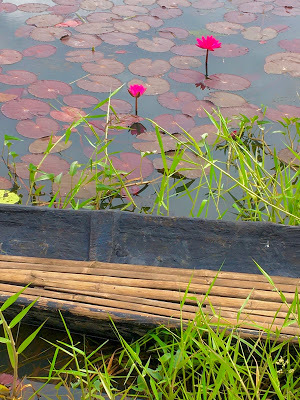
Lotus, meet mud. Mud, meet lotus
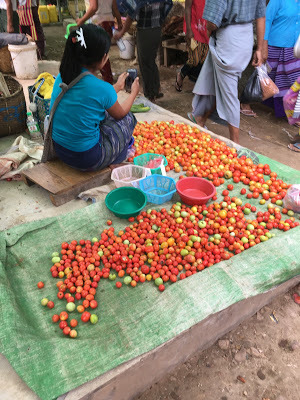
We arrive at a muddy bank and disembark the boat. We have come to the village market, a market that changes location around the lake depending on the day of the week. This market is very much like any other busy market, except this one has an eye to boat-tourists. The line of stalls leading in from the muddy path is full of souvenirs vendors rather than produce or fish. Once past the gauntlet, there is a normal village market, full of fruit, vegetables, wriggling eels and fish.
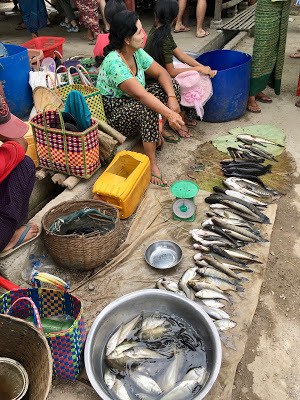
We walk the narrow market aisles, peruse the goods on offer. My One buys a small Buddha statue, giving a small profit to the local vendor. She takes the money and waves it over her goods, fanning them with the worn bills. It is her first sale of the day, and this ritual will bring her luck for a profitable day. It is a rite that is performed in markets around Southeast Asia.
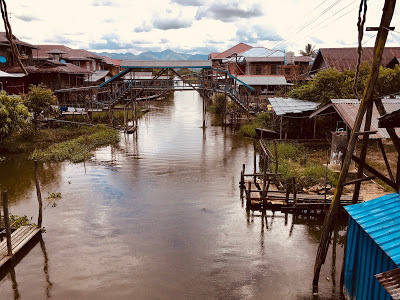
A "Street" in the Local Village...
Leaving the market behind, our boatman piloted us through the narrow water channels that serve for streets in one of the local villages. There are villages scattered around the shores of the lake, some on narrow strips of solid ground, others perched on stilts over the shallow waters. There are two sources of livelihood for the hamlets. There is a living to be gotten from the lake itself, growing tomatoes and other vege on berms of soil surrounded by the water. The other source of income are the tourists.
There are silversmiths, boat-makers, weavers, and small workshops that produce the local cigars, the Burmese cheroots. The boatman bring the tourists to these workshops, and the local entrepreneurs guide the tourists through the intricacies of weaving cloth from lotus stems, or rolling a small cigar from local tobacco. When the tour is completed, there is always an opportunity to purchase some of the wares. Thus is the local economy sustained.
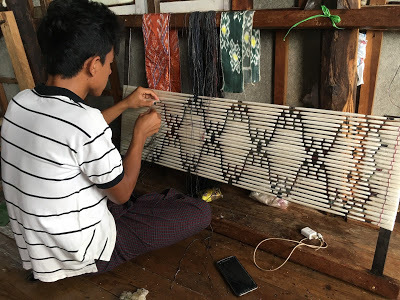
Setting the Pattern for a Weave...
The weaving shops are a complete cottage industry. Using cotton, silk, or fiber obtained from the stem of lotus plants, workers create fabric with intricate patterns. Fiber is spun to thread, thread to yarn, the yarn is woven on foot-pedal looms, and all under one roof perched on stilts above the still waters of the lake.
Not immune to the lures of the gift shop, I purchased a shirt, doing my part to throw some money back into the local economy.
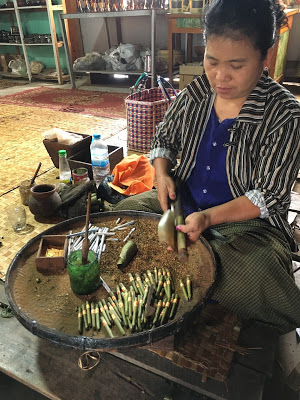
Rolling the Local Smokes...
Burmese cheroots are a traditional smoke here in Myanmar. While they have been supplanted somewhat by ready-made cigarettes, there are still a great many local folks that favor these hand-rolled cigars. We departed the cigar factory, but not before I had a small bundle of cheroots tucked into my bag. If nothing else, the smoke they produce is good for chasing off mosquitoes. In truth, the cheroot is not as bad as all that, and my stock of cigars was running low. Besides, the sight of a Farrang smoking a traditional cheroot never fails to bring smiles and comments in the local tea-shop.
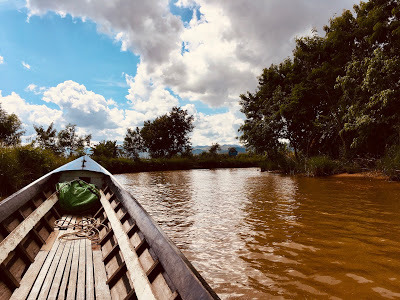
Heading Upriver...
Our boatman steered the long-tail away from the lake and up a winding, muddy river. This was pure joy; the roar of the engine against the current, the jungle pressing in on both banks. The boat shot over bamboo weirs as we climbed the current, with the boatman raising the prop just enough to clear the weir. The narrow boar would hesitate against the current as we scraped over the weir, then plunge ahead as our pilot lowered the spinning prop back into the muddy water.
Our lunch stop was along the river, at a shady outdoor café. The young folks that served us were polite, friendly, and spoke English. There were no local folks. Welcome to the Tourist Trail. But the food was good, and the setting was idyllic. We paid more for our lunch than a normal joint, to be sure, but we could see where the money was going. I did not begrudge the extra few dollars spent on our meal.
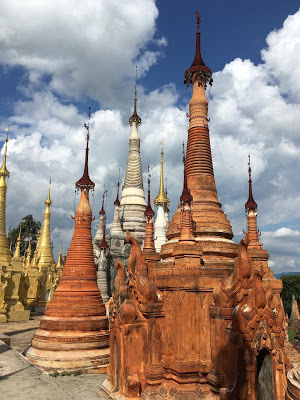
Many, Many Zedi...
The last stop on the river was the small village of Inthein. From there we set out on foot to tour the complex of the Shwe Inn Thein Paya. More than a thousand Zedi are clustered up a steep hillside surrounded by jungle. Most of the large and small pagodas date from the 17th and 18th centuries. Some are gleaming and bright, others falling to ruin and leaning at crazy angles. It is a strange place, and a wonderful location for a barefoot stroll over the sun-baked stone walkways.
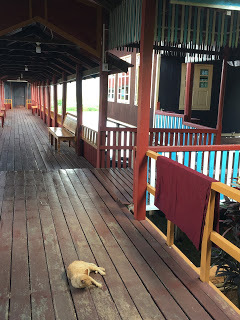
Meditative Felines...
Workshops, markets, temples, Oh My! Back out on the lake, we stopped at the Leaping Cat Monastery. The hulking wooden structures were perched above the lake on thick pilings of teak. None of the cats that I saw were doing much leaping. It was too hot for that. I suppose they were meditating instead.
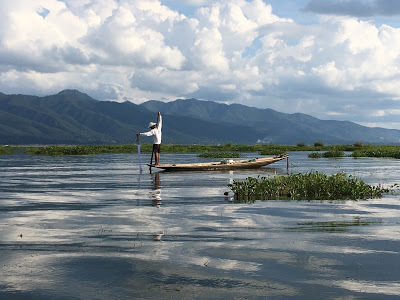
An Icon on the Water...
The afternoon sun was hot as our boat roared back up the lake towards town. Along the marshy shores we saw the raised beds of tomatoes stretching almost as far as the eye could see. The bushy rows of tomatoes seemed to grow right out of the water. A closer look revealed carefully tended berms of water-logged soil. It was like a giant hydroponic garden.
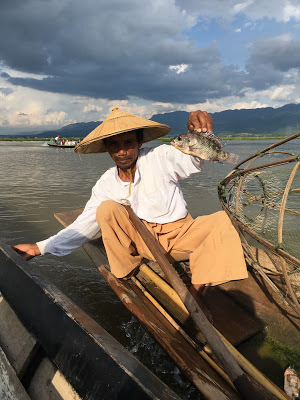
The Money Shot...
There was yet one more tourist obligation to fulfill. We had to stop for a photo-op with one of the local fishermen. This is the photo that everyone wants, the image emblazoned across the cover of the Lonely Planet guidebook. Here is another irony. The "Fishermen" who work closest to the route of the tour boats are more engaged in being icons than they are in fishing. To be sure, there are fishing boats scattered across the lake, and the majority of those are meant to catch fish and eels from shallow waters. The fishing boats along the water route to town, however, are after a different catch. These folks know that the tourists want that important photograph, and they are happy to play the role for a small fee.
Our boatman slowed alongside one of the fishing boats, allowing us a chance for the image. We slid up next to the smaller craft and the occupant grabbed our gunwales, holding fast with one hand while raising a small fish in the other. I obliged him with the photo you see above, and made my contribution to his fund. Everyone has got to make a living.
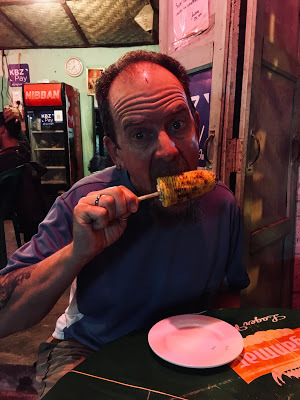
Everything Tastes Better on a Stick...
Our boatman deposited us on the shore of the busy main canal. I left him a good tip, furthering my efforts to support the local community. The boatmen themselves get a relatively small cut for their efforts, while a large share of the fare goes to the booking agents. Making sure our guy got a decent cut of the profits seemed like the right thing to do.
The heat of the late afternoon was on us, and it was time to relax. Having played the good tourist, I wanted nothing more than our quiet veranda and a good cigar. Night fell while I saw to both of those needs.
My One and I set out into the sultry night, looking for food that was other than curry. We found a local Myanmar BBQ joint and settled into a meal of grilled food on sticks. It was a busy, family-run joint, open to the night air. Local folks pulled up on their scooters, ordering BBQ to go. The meal was long and slow, an altogether enjoyable evening. When our tables was covered with discarded skewers, and we could not eat another bite, we ventured back to the veranda for another chorus of the night song.
Our tour of Inle Lake was a good day, despite the oddity of being firmly set on the Tourist Trail. So it goes with travel to the Big Sights. One should not expect to be alone amongst the famous places that so many want to see. I was thankful that we have the freedom to travel in the shoulder season. I cannot imagine what Inle Lake is like in the high season of December, when the crowds descend on this quiet place. As it was, the day turned out to be a lovely balance, a mixture of destination travel and small things discovered amongst the large.

Thanks for your interest in my travel blog. I do hope you enjoy it. If you liked what you read here, how about a free short story? My flash fiction piece "Broken Luggage" has recently been featured at the great online journal Five on the Fifth. You can check it out here:
"Broken Luggage" at Five on the Fifth
Or perhaps one of my other novels? All of the information is at my website:
Marco Etheridge Fiction
You can check out books, blog posts, book reviews, or even get a free book. Just look for the big button that says "FREE BOOK." It's kind of hard to miss. Happy reading!!
Published on December 02, 2019 02:54
December 1, 2019
Myanmar Chapt. 7 -- Nyaungshwe
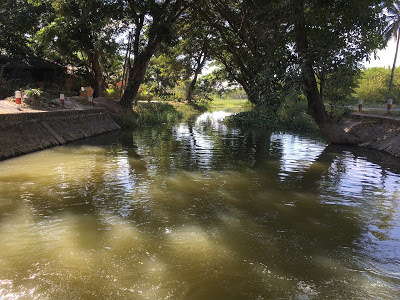
All Canals Lead to Inle Lake...
The day came hot and bright, and with it the promise of walkabout in a new town. Nyaungshwe is the largest small town adjoining the ecological preserve of Inle Lake. The lake and the town are located in the Shan Hills, the eastern portion of central Myanmar that make up the Shan State. The lake sits in a wide, flat valley, surrounded on all sides by green-clad mountains.
People often ask me what I do on my travels. My answer is that I walk around and look at things. Sometimes I find big things, other times I find small things. Each country or city has its important monuments: The Statue of Liberty in New York, Angkor Wat at Siam Reap, or Luang Prabang on the shores of the Mighty Mekong. A traveler may see any one of these, and yet not know a thing about the land and people of a place. Walkabout allows one to experience day-to-day life; the small sights, smells, and tastes that make up the fabric of a country and its culture.
Here I risk the danger of letting my snobbish nature show, but I will plunge on nonetheless. I have listened to well-heeled travelers tell me of having been to Cambodia of Laos. They fly into Siam Reap, tour Angkor Wat, then fly away. Or they spend a few day in the UNESCO World Heritage Site of Luang Prabang, claiming that they have seen Laos. I do not deny the wonder of both of these amazing treasures. Yet I also know that there is so much more which defines a new land. One of the best ways to experience these small things is to set out on foot with no clear destination in mind. The Travel Gods rarely fail to reward such effort, even if the reward comes in surprising and mundane ways.
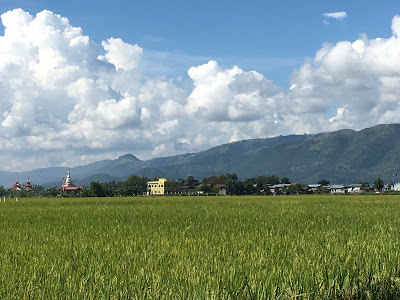
The Walkabout Calls...
Our breakfast, including real coffee, was served by our smiling host. The breakfast room was on the second floor of the lodge, with views all around. The land spread out before us, flat and green in the morning sun. I could see small lanes leading out into the flat, green countryside; paths that led towards the marshy lake. Clouds floated over the tops of the mountains, while a hot sun beat down on the rice paddies. It was more than a traveler could ask for, more than I could resist, and we were not long in setting out.
We crossed over the canal in front of our guesthouse compound and headed away from the edge of town. The gravel way led due south, following the path of the sluggish canal. There was water everywhere, on either side of the path, in the canal, or glistening below the emerald green of the fields of rice. We had no fixed destination, no demand on our time, and nowhere to be.
Lying in the road, My One found the carcass of the biggest grasshopper I have ever seen. The thing was a full four inches long, more than an inch thick, and iridescent green. Small fish broke the surface of the canal, hunting insects that were not so gargantuan. All manner of birds flitted through the branches of the scrub bushes on the side of the path. It was glorious walking on a sultry morning.
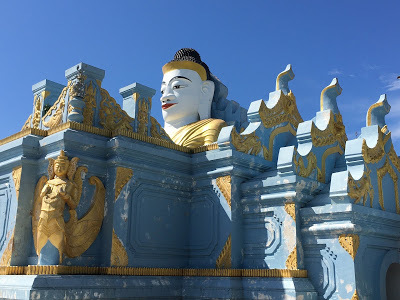
A Village Temple...
We came to a meeting of ways and chose the one that looked the most traveled. There was a line of buildings in the distance, including the golden gleam of a few small pagodas. The rice paddies were on our right hand, and the beginnings of the lake marsh on our left. The raised pathway led past teak houses on stilts. Farm folk were going about their chores. We greeted them with smiles and our best Ming-ga-la-Bah, which is always answered with a beaming Burmese smile.
At the far end of the lane, defining the very large square we seemed to be circumnavigating, we bumbled into a farmer's compound. He steered us away, but gently and with a smile. Finding a path that led north along the main canal, we strolled past a small, brightly painted temple. Lotus blossoms grew in the ditch alongside the path, anchored by long roots to the mud beneath. There is a Buddhist saying: No mud, no lotus.
We were heading back towards the town now, and our pathway became a proper road. We could hear the unmuffled roar of long-tail boats plying the canal, caught glimpses of them between the buildings. The buildings seemed to be mostly warehouse structures. There were piles and piles of wooden crates stacked up in front of each of these buildings. We soon learned what the crates were for.
There were mounds of tomatoes, mountains of tomatoes, long tables of tomatoes. Workers stood at the tables, sorting tomatoes into crates. The combination of rich, flat bottom land, ample water, and fierce sun make this lake valley a prime tomato producing region. The tomatoes all seem to be of the Roma variety; smallish, oblong, and bright red.
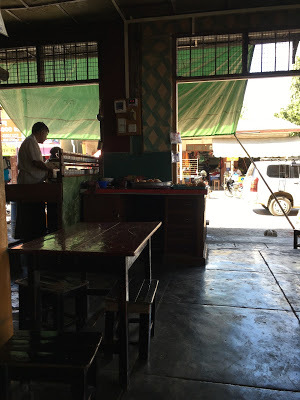
The Local Tea-Shop...
We wandered closer to town, close enough to attract the attention of the Boat Shills. Inle Lake is the big attraction here, and no visit is complete without chartering a long-tail boat to tour the lake itself. It is not yet the high-season, so there are not enough tourists to go around. Hence the Boat Shills. These guys run around on scooters, looking for tourists to pitch. We received a fair few of their pitches, which we politely declined. Today was for walking. We had set aside the morrow for a boat excursion.
The road became busier. There were tractors hauling loads of tomatoes, taxis hoping for a fare, and the ubiquitous stream of scooters. Where the main canal crossed under the main road, we saw the idle fleet of long-tail boats moored at many rickety docks. Turning right again, we began strolling into the town proper, the last leg of a very large box.
The afternoon was bringing the clouds down from the surrounding mountains, and with it the threat of rain. By early November, the rainy season is ending, but it is not completely spent. It was time for cup of chai, preferably at a joint that had a roof.
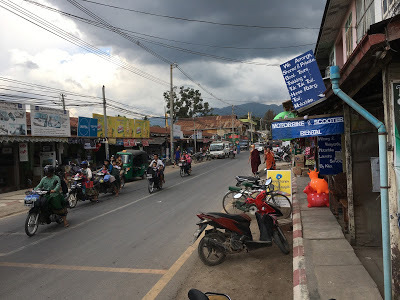
Main Street Under Clouds...
We spent a good bit of the afternoon hanging out in the tea-shop and watching the world go by. The busy little main street gave us all the entertainment we needed. When the threat of rain eased, we headed back to the guesthouse for a late-afternoon smoke and some well-earned relaxation on the veranda of our cute little bungalow.
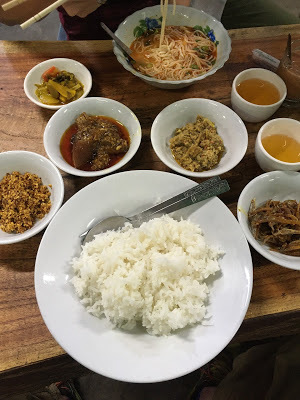
Curry With Most of the Fixings...
The night fell hard and black in a town where streetlights are few and far between. Armed with our trusty LED torch, we headed out to find some dinner. We were not disappointed. A typical Myanmar curry revolves around the rice. Accompanying the rice are a small dish of curry and a variety of savory side dishes. There are pickled things, spicy things, vegetable things, and dishes I cannot readily identify. Some are wonderful, some are strange, and the side dishes seem to change each day and at each curry joint. The assortment you see in the photo above was only a part of the meal. Before I could tuck in, more dishes arrived.
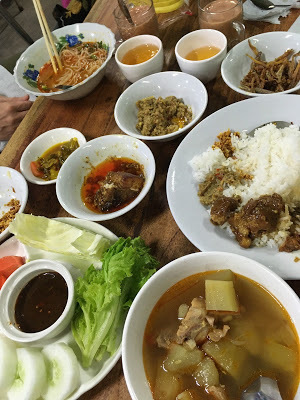
And with All of the Fixings...
I had to rise from the table in order to capture everything in one photo. Besides the dishes mentioned above, there was a lovely soup and a big plate of green vege. This extravagant feast will usually cost about 3,000 kyat, or two dollars US.
Our meal complete, we wandered back to our bungalow. Once more enjoying our perfect veranda, we were serenaded by the chorus of night critters. Tree frogs tried to out-sing the crickets, while the Hoo-How birds cried out from the dark trees above us. Two giggling girls made their nightly rounds, offering to spray our veranda with the biggest can of bug repellent I have ever seen. We declined, preferring to shoo the mosquitoes rather than suffer the effects of a toxic cloud.
It had been a quiet day, a small day, a day blessed by a remarkable walkabout. There was nothing wondrous to report, unless it was the small wonder of discovering small things. Tomorrow we would do the big things: A boat tour of Inle Lake. For tonight, we were content to sit and talk and laugh. the big things could get along without us.

Thanks for your interest in my travel blog. I do hope you enjoy it. If you liked what you read here, how about a free short story? My short fiction piece "The Last Lost Eye" has recently been featured at the great online journal Literally Stories. You can check it out here:
"The Last Lost Eye" at Literally Stories
Or perhaps one of my other novels? All of the information is at my website:
Marco Etheridge Fiction
You can check out books, blog posts, book reviews, or even get a free book. Just look for the big button that says "FREE BOOK." It's kind of hard to miss. Happy reading!!
Published on December 01, 2019 09:32
November 29, 2019
Myanmar Chapt. 6: Heading North
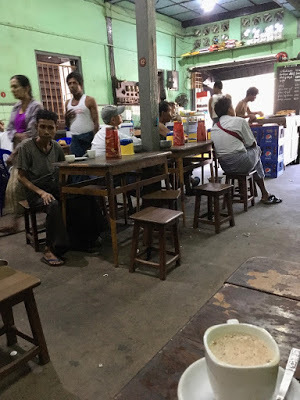
Morning at the Tea-Shop...
Myanmar is an oddly shaped land, resembling a very rough diamond with a long, curving tail. The northern tip of the diamond runs into the foothills of the Himalayas. The southern tip is the tangled delta of the Ayeyarwady (Irrawaddy) River, and beyond that the Andaman Sea. The tail reaches far to the south, sharing a boarder with Thailand, and splitting the narrow isthmus between the Gulf of Thailand and the Andaman Sea.
Traveling south to north is a slow process, as is any overland travel in Myanmar. Everything is slow. Aside from the main highway between Yangon and Mandalay, most roads are narrow and rough. A traveler cannot use distance as an accurate measure. First-World yardsticks of distance versus time are of no use here. Time, then, becomes the only measure. To get anywhere in this country, a traveler will need time, and usually more than he or she thinks.
North to south, Myanmar is divided by three rivers. The rivers are separated by jungle-clad mountains. From west to east, the rivers are the Chindwin, the Ayeyarwady, and the Sittaung. It was up the central valley, the valley of the Ayerarwady, that we would travel, bound for the small town of Thazi. This is the stopover for travelers bound for Inle Lake. The lake itself would be a long two days of travel, by train and vomit-van.
The rutted alley that leads to the Bago train station is lined with tea-shops. Let me tell you, friends and neighbors, there are few better ways to start the day than a busy Myanmar tea-shop. A man with the purple smile of a betel-chewer greets us at our table. He is wearing a dirty wife-beater and a longhi. The open-air shop is packed with local folks starting their day. Vendors, cops, taxi drivers; they are crowded around the decrepit wooden tables. Our tea arrives; thick, milky, and sweet. A plate of samosa drops to the table. You can eat them or not. On every table is a thermos pitcher of plain oolong tea. You drink down the first sip of the chai, then dilute it with a bit of oolong to cut the sweetness of the condensed milk.
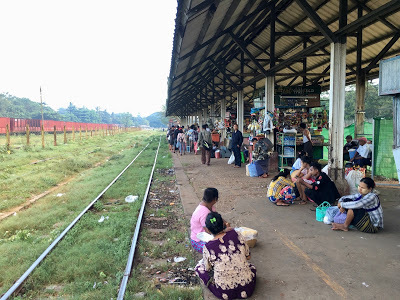
The Busy Main Line...
Ready for our long day of train travel, we join the folks on the platform. The morning is already hot, with the promise of more to come. The train from Yangon is late. It is almost always late. I spend the time watching people, of course. There are no Farrang here, just local folks waiting on the train. The vendors are ready with baskets of food and drink. When the train arrives, they will storm it, hoping for a sale.
If you look at the picture above, you will see grass-grown tracks leading north. These train tracks are not some forgotten siding leading to nowhere. This is the main line, the Yangon-Mandalay line. Take note, traveler. The grass grows more quickly than the train rolls.
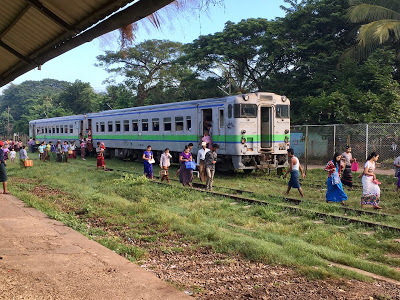
Commuting Bago Style...
While we are waiting, an ancient two-wagon commuter train pulls into the station. Those aboard clamber down without benefit of platform or ladder. They have come from an even smaller town to do their business on the dusty streets of Bago.
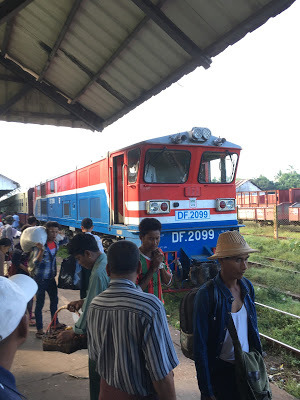
The Mighty Locomotive...
The echoes of a train horn sound out over the sultry morning air. When the locomotive appears, it is like a machine from another era. This is not an impression, it is a fact. The Myanmar rolling stock, even on the mainline, is half a century old.
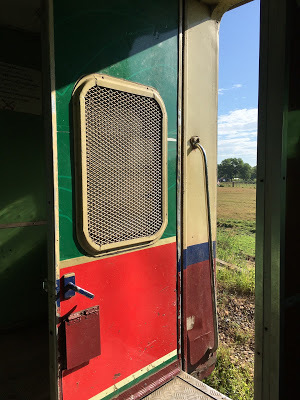
The Smoking Section...
Today we are traveling in the Upper Class wagon. The leg from Bago to Thazi will take at least ten hours to cover a distance of 460 kilometers, or 276 miles. The math is simple: we will not be traveling quickly.
Upper Class means that a passenger will have padded, reclining seat. The seat will probably be reclined permanently, fixed in whatever position if was in when it ceased to function. Like the Ordinary Class, the windows are open. There are steel shutters that can be lowered against the rain. Mind your fingers if you chose to adjust the shutters. They will fall like a guillotine if mishandled.
If you need a smoke during the long trip, do not despair. The smoking section is near the open door. Take a seat on the floor, light up, and watch the rice paddies as they slowly roll past.
Slowly, that is the key word. My Heart and I relax as we watch the countryside roll past. Far to the east and west, green hills roll up into jungled mountains, but the valley to the north runs on forever. The train chugs along, stopping in small villages and larger towns. The rhythm of the journey blends together. Rice paddies and fields stretch out on both sides of the tracks. Snowy egrets stand like statues, waiting for a careless frog or fish. Everywhere the landscape glistens with mirrors of standing water, punctuated by emerald green. The vendors climb aboard, hawk their wares against the lurching of the train cars. Time ceases to move; it simply is.
Ten hours have passed, night has fallen, and still the train rolls north. The lights have come on inside the train, illuminating the car in a ghostly wash of fluorescence. The light attracts insects, clouds of which find their way in through the open windows. The smaller bugs mob the overhead lights, creating dancing swarms that swirl and bob. Huge dragonflies attack the swarms, careening about in a feeding frenzy. People are sprawled across the seats, swaying back and forth with the rocking of the train. The dragonflies perch on sleeping passengers, gathering their strength for another go at the insect buffet above.
I would love to tell you that the trip was all a pleasant dream, but that would not be the truth. Ten hours stretched to twelve, and the last two hours were hard. The novelty, the charm of train travel, both of these had worn thin. We were left with stiff muscles, grimed with dust and grit, and ready to be on unmoving ground.
The night was full and dark by the time we reached our destination. We made out way out of the decrepit station and past the sleepy scrum of taxi drivers. It was a short walk to our guesthouse, past rows of open-air cafés and bars. Scooters raised clouds of dust as they passed us. Two-wheeled horse carts clip-clopped along the dark street, pulled by small, lean horses.
We had paid the Travel gods for our passage. Now it was time for food and sleep. After stowing our bags at the very modest and friendly guesthouse, we found the nearest open joint. It was wonderful to dig into a dinner of Myanmar curry with all of the side dishes. Then is was time for sleep before the next leg of our journey.
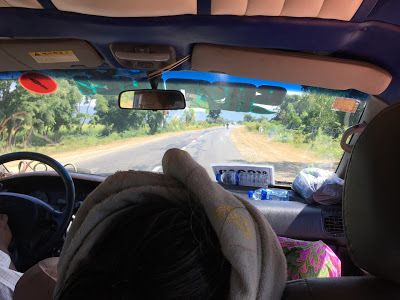
The Vomit Van View...
The morning was bright and hot, the local tea-shop was busy, and the street theater was in full swing. Another day of travel lay ahead, twisting over the jungle and mountains to Inle Lake
The road distance from Thazi to Inle Lake is about 172 Kilometers, depending on who is doing the counting. The driving time is about five hours. That's a heart-stopping speed of 34 kilometers per hour, or 20 mph for you folks on the far side of the Pond. Remember, Traveler, it is all about the time to your destination, not the distance.
There are two ways to get to Inle Lake: Bus (read Vomit Van) or train. The train is so slow that the Burmese call it "The Slow Train." If they think it's slow, you can take that one to the bank. My One put her small foot down in no uncertain terms. No more long train rides for a least a few days. That meant we had to deal with the dreaded Bus Manager.
The Vomit Van stop was next to our guesthouse. There are no set fares, no schedule; the vans leave when they are full. The sleazy bus guy quoted us an exorbitant price, and the hard haggling started. Once we got the fare down to the proper range, we had to wait on a van. There were some shenanigans with an actual bus that would barely run, and we the only ones one it. When we protested and demanded our money back, a functioning Vomit Van appeared, along with the smiling sleaze ball. Finally sorted, we crammed into a van full of locals; full being the operative word.
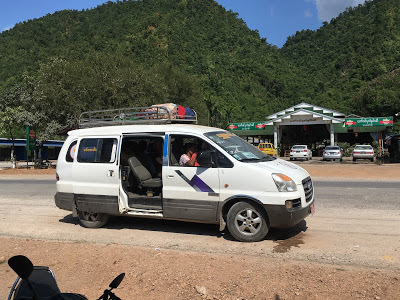
Vomit Vans are the ubiquitous form of travel for much of Southeast Asia. They are aptly named. The drivers get paid by the run, thus they are in a hurry. The roads are bad, and often twisty. Add in a few Farrang who are unused to the cramped conditions and non-functional air-con and, well, you can guess the rest. Fortunately, we were the only foreigners aboard, and the ride was not as bad as some I have been on.
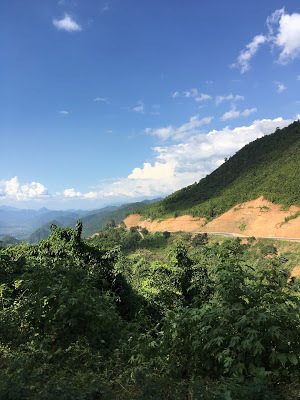
Our little van climbed the hills, screeched around hairpin turns, and climbed some more. The road wound its way over steep hillsides, climbed deep river valleys. Thick jungle rose away on every side. The road itself was in what appeared to be a constant state of decay and repair. There was as much gravel as there was pavement, and what there was by way of pavement was rough chip-seal laid by hand.
We saw the workers laying the chip-seal. There were a few machines for the heavy digging and compacting, but most of the work is done by hand. Working in the fierce heat, women carry heavy baskets of crushed stone atop their heads. They dump it on the road, where others spread and rake the piles. On the side of the road, men cook barrels of asphalt and oil over open fires. The oil mixture is spread over the rock, by hand of course. The whole operation looked like one of the lower hell circles from Dante Alighieri's Inferno.
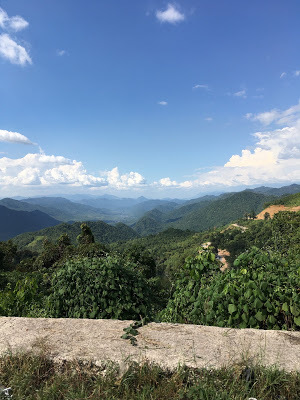
Somewhere far up the mountains, we stopped for lunch. There is some complex kickback system that determines which drivers stop at which roadside café. I don't understand it fully, but I know such a system exists. The food at these joints is surprisingly good, and cheap as well. There aren't any special "Tourist Prices," unlike our sleazy bus manager back in Thazi.
We reached the high country around Kalaw, a former British colonial outpost at an elevation of 5,000 feet. These high valleys were the site of tea plantations. It was odd to see the local folks bundled up in parkas and hoodies, trying to fend off the freezing temperatures of seventy degrees Fahrenheit. We made a quick stop, and couple of young Farrang women crammed into the van.
From Kalaw, the road drops back down the mountains, twisting and turning until a butt-sore traveler reaches the town of Shwendaung. This is the jump-off for Inle Lake. We formed an impromptu collectivo with the two foreign women, and negotiated a decent taxi fare into the small town of Nyaungshwe on the borders of the lake.
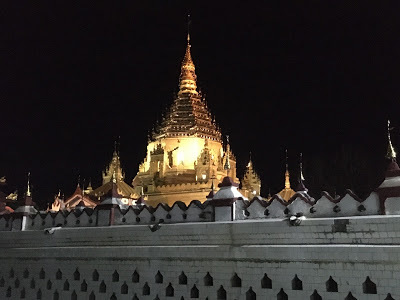
Night, Nyaungshwe...
I liked Nyaungshwe from the moment we got there. It is a dusty little burg, laid out around a small central market. This is a popular tourist spot, but it was just the end of the rainy season. The full flood of the high season had yet to begin. This place is probably unbearable in mid-December, but at the time of our arrival, it was just right. There were plenty of good cafés and guesthouses, but not yet enough Farrang to make it feel cramped.
Our taxi dropped us at the guesthouse, and we discovered that My One had chosen wisely. The host was charming, and we ended up in one of those wonderful bungalows that are remembered long after the trip is done. Our travel days were over for the nonce.
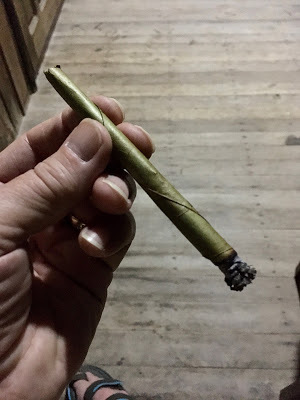
The was travel done, the bungalow occupied, and dinner was found and consumed. It was time to enjoy the veranda and the sensation of sitting still. For me, that means a good evening smoke. I set aside my traditional cigar for the equally traditional Burmese Cheroot. These rustic smokes have a long history in Burma, now Myanmar. The outside wrapper is dried leaf of carbia myxa (thanal-phet). The filler is a mixture of bits of dried wood and crushed tobacco. The Cheroot features a filter of a sort; a rolled section of corn husk. The result is pungent and sharp, nothing that is going to win away fans of Cuban puros.
With two days of travel behind us, we were looking forward to local exploring from our new base of operations. Tomorrow: Inle Lake.

Thanks for your interest in my travel blog. I do hope you enjoy it. If you liked what you read here, how about a free short story? My short fiction piece "The Cave" has recently been featured at the great English journal Storgy Magazine. You can check it out here:
"The Cave" at Storgy Magazine
Or perhaps one of my other novels? All of the information is at my website:
Marco Etheridge Fiction
You can check out books, blog posts, book reviews, or even get a free book. Just look for the big button that says "FREE BOOK." It's kind of hard to miss. Happy reading!!
Published on November 29, 2019 03:57



